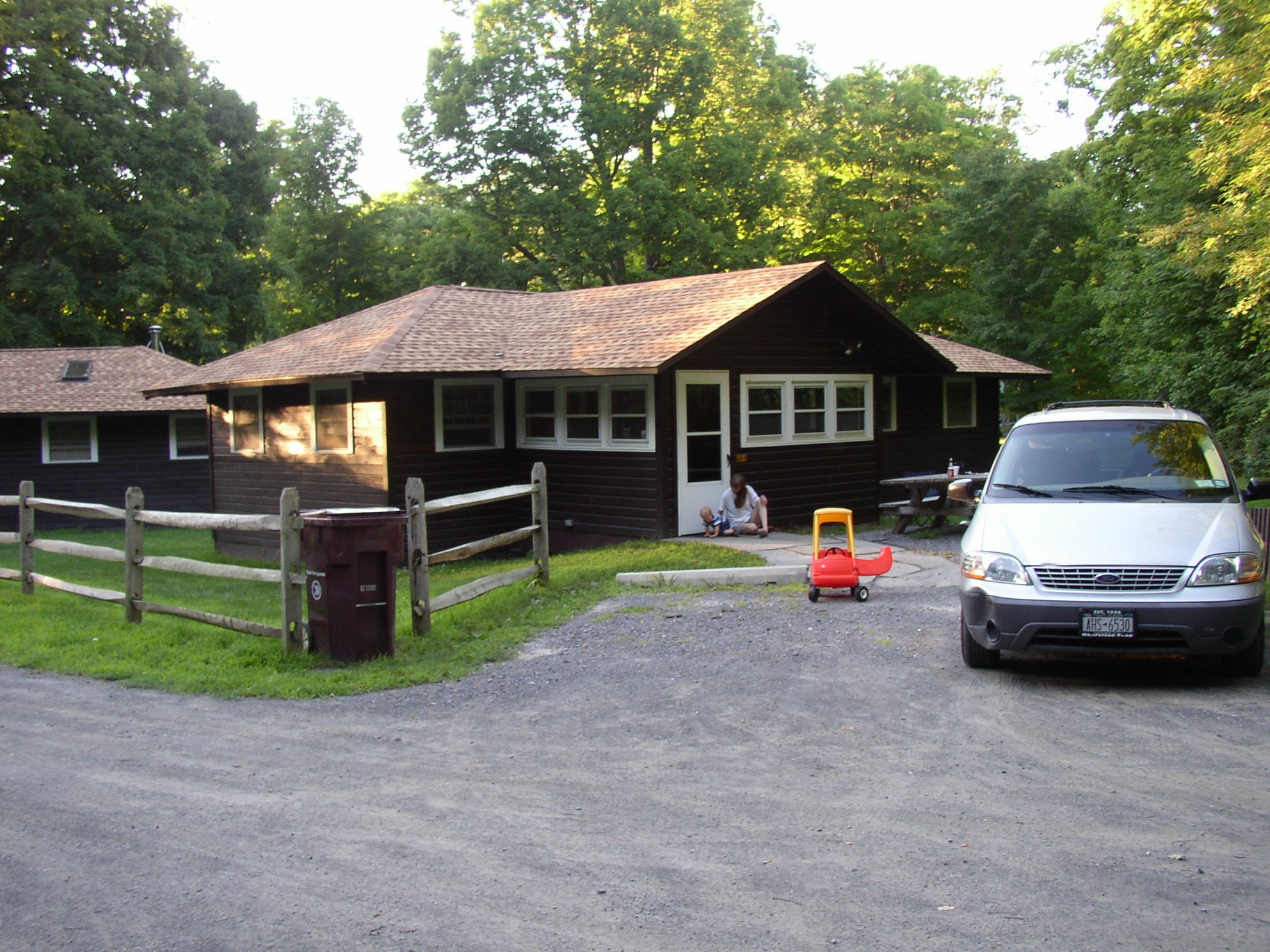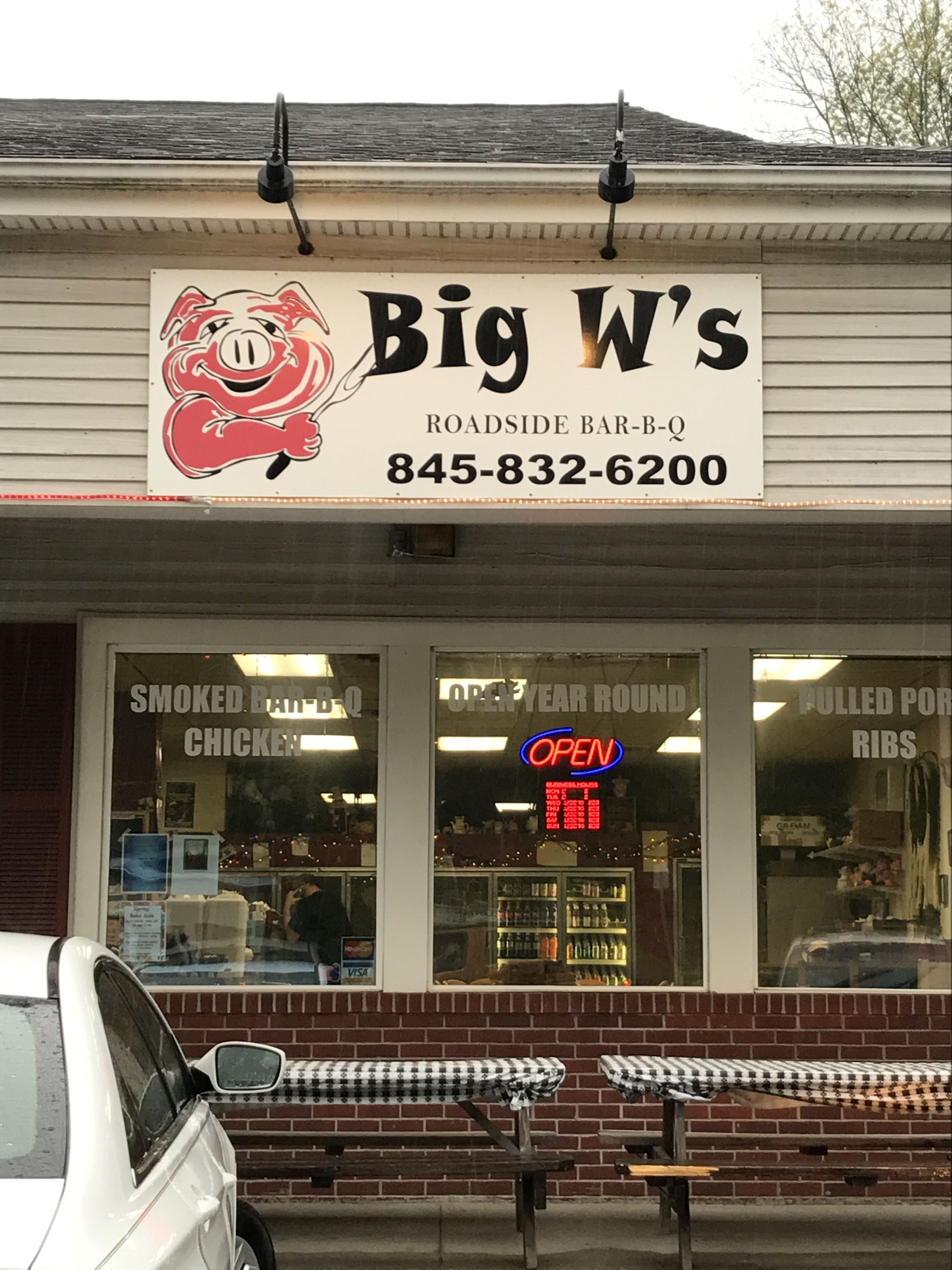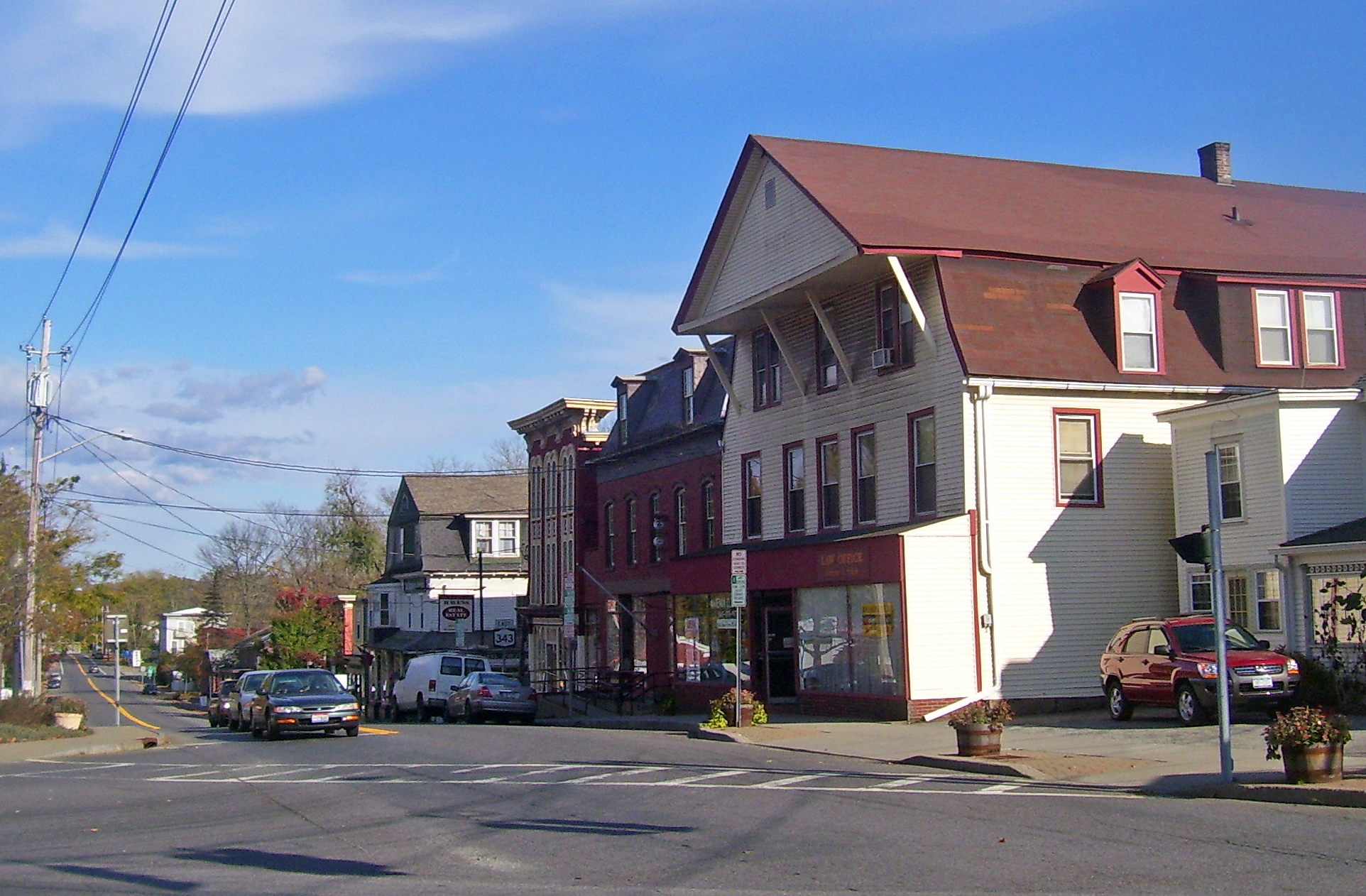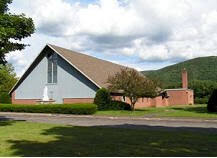
It never ends on Duffy’s Creek. I will but it doesn’t. There’s always something going on around this little crossroads of Man and Nature. The tidal flow is always moving even when it seems still. Things are always changing. Nothing is static. So whether by way of a permanent relocation to Trisha’s Mountain or by way of my untimely death, I’m forced to accept the fact that The Creek will go on without me someday.
I’ve seen lots of places and people go on without me before, so I know it’ll be fine. And if I make it out of Valley Stream alive and spend the rest of my days on Trisha’s Mountain, so will I.
Still. It’s a bitter pill.
None of us is terribly important to the place around us, but we’re all terribly important to the place around us.
So even if it isn’t true, part of me truly believes this place will go to hell without me.
Case in point, if I hadn’t gotten back from my last stretch of time up on Trisha’s Mountain when I did, and if I hadn’t been sitting on the couch near the window, and if I hadn’t jumped into action when I heard the commotion, a duck may well have been viciously murdered in cold blood in South Valley Stream.
And it wouldn’t have been the first.
Early in our almost twenty year run here, back before we replaced the rotting deck with the wobbly patio, I woke one morning to the grisly discovery of a decapitated green mallard head under the steps of the deck.
It was clear that the neighborhood stray cats had formed their own La Cosa Nostra, and they were warning me to stay out of their business.

But those ducks are my ducks, and I’ll be damned if I’m going to let some furry thugs attack them. Or other ducks, for that matter. Currently there is a feral domestic duck, a compatriot of the idiot whose feathery ass would have been cat food without my intervention, a freak of nature whom we refer to as “Three Mile Island”, who has run every good, law-abiding mallard off the creek, and I’ve put him on notice for his churlish insolence.
This aggression will not stand, Duck.
Because I’m personally responsible for every one of God’s creatures that lives in and over my creek; the ducks, the swans, the geese, the pipers, the plovers, the yellowlegs, the gulls, the terns, the kingfishers, the cormorants, the swallows, the herons, the egrets (I have a few), the hawks, the ospreys, even the turtles and the peeping frogs and the muskrats and the bats and the little killies we used to catch in milk bottles tied to strings and the weird fish that come here to commit suicide every May.
Oh yeah, and the Bald Eagle.
All of them. My creek, my responsibility.
But wait, you say: Didn’t you and Mrs. Duffy buy a house and a couple of acres up in the country? Weren’t you the guy who was going on and on in the introduction to this book (it’s a book?) about the 2% ratio of unrepentant assholes to the general population of the region surrounding your creek? Getting all snarky about the crumbling quality of life on Long Island? Rhapsodizing about how life got so much more pleasant north of the Red Rooster as you drove up Route 22? All giddy about the bluebirds on the rail trail and the rainbow crosswalks in Great Barrington? Aren’t you planning on making that drive north in Lou the Subaru one way someday, possibly with a confused old dog and three pissed off old cats? Isn’t the plan to leave Duffy’s Creek behind forever?
Yeah, that was me. And, yeah, that’s still the plan.
But not today.
As much as we’re drawn to the pull of the Mountain, and upstate in general, the thought of giving up The Creek kills us. Trisha has said, more than once, “I wish we could just take this creek and the gardens with us and leave the rest of Valley Stream.”
I like that she says things like that out loud.
Mind you, it’s the noise and the trash and the traffic and the taxes that would ultimately push us out. But, in the ultimate irony, even though it’s people who create the problems, 98% of the folks that I encounter down in the Valley are delightfully entertaining, most of the time unintentionally. Trisha and I enjoy critiquing their various walking styles as we watch them on the public path along the Left Bank.
There’s just too many. And as much room as we have on The Mountain, there’s just no place to put a creek. Besides, you’d have to take Jamaica Bay and the Atlantic Ocean, otherwise you’d have no water.
The other problem is the creek doesn’t belong to us. We have a deed on a cornfield in Copake Falls, but we don’t own the creek.
But then again, I sort of do.
And I know my wife and my son and my brothers and my sisters and my dead parents and my neighbors and even my dog wouldn’t mind me saying this:
If it belongs to anyone, It belongs to me.
To prove this assertion, it’s necessary for this narrative to become, as the most famous writer I ever bumped into on the street famously said, “unstuck in time.”
I’m five years old, and I’ve discovered that you can walk behind twelve 60-foot-wide backyards and get to our backyard directly from behind the Sportsman’s Rendezvous Bar up on Mill Road. Blazing a little trail, pretending like I’m an Indian, innocently oblivious to the fact that the phrase “pretending like I’m an Indian” is highly offensive, I’m starting to notice the tides and the plants and the birds. Even my little pre-school mind’s eye can see that I live in a uniquely cool place compared to other neighborhoods around us. And my life here was born of dumb luck. My mother told my father that the only way she was moving from Astoria to Long Island was if they could buy a house on the water. I could have easily ended up on a canal in Freeport, but a family by the name of Taylor that bought a brand-new house on a creek in South Valley Stream in 1950 suddenly decided it was too small in 1954, just as my parents were diving into the market.
On my trail, I discover a sign, a road sign, except it’s on my creek, so it’s really a creek sign, a sign that years later I would regret not stealing. The sign is posted behind Mr. O’Neill’s backyard, warning boaters that exceeding 5 mph is a violation of a Nassau County Ordinance. A duplicate sign was attached to the footbridge over the creek, four backyards down from ours.
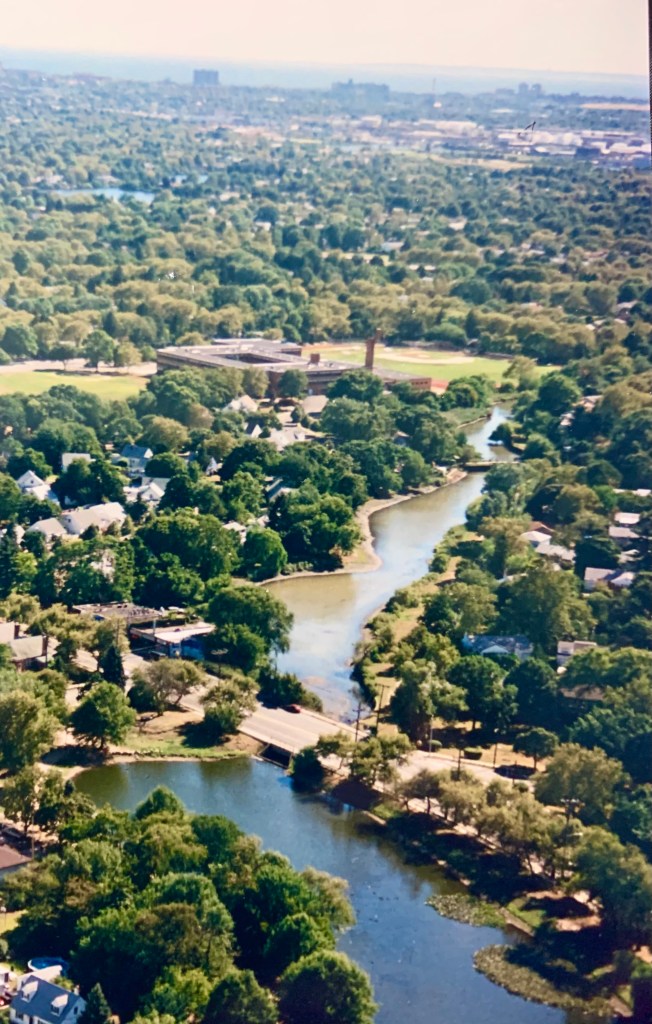
Way back then, you could still get under the bridge at Rosedale Road and get all the way out to the Jamaica Bay from our backyard, a fact that my father used as the launching point of a terrifying made-up bedtime story designed to keep us from taking the aluminum rowboat out for a spin when he wasn’t around. Every once in a while people would cruise up the creek and pass by the backyard in motorboats, grinning and waving at us. To my little six-year-old boy perspective, they looked like they were having the time of their lives.
I know my drunken high school friends were having the time of their lives when I said, “Sure! Go ahead! Take the boat out!” as I was hosting a giant party in the backyard during the summer between 11th and 12thgrade, as my poor parents relaxed obliviously up in the Adirondacks. My charming young peers decided to throw beer bottles into the backyard of a girl who lived down the creek on Brook Road, a sweetheart who never did anything to deserve either that or dying in the World Trade Center 31 Septembers later. My boating friends happily directed the responding policemen to the backyard party, where we all got off with a warning because we were all white kids, and it was the end of their shift.

When Jack and I take the kayaks out on the creek, people on the path and in the backyards have been known to whip out their phones and start filming us like we’re famous or like something important is happening. That’s how rare a boat on the creek is now. Being a teenager, this pisses him off no end. Being the old man who owns the creek, I’m delighted and amused.
Unstuck again. I’m ten years old and the creek is frozen solid in wintertime, a condition that rarely happens anymore. When the tide goes in and out, it leaves sheets of ice along the banks, which are fun to jump up and down on and break like panes of glass. Ace the Fat Beagle and I go walking out on the ice, sliding our way down towards that pedestrian bridge, the spot that launched the dependency years of every stoner and alcoholic to emerge from Valley Stream South High School (the place that Trisha and I now refer to as “Big Brick”).
Years later, the bridge would be removed in the Mid-Aughts after a young would-be entrepreneur tried to charge kids a toll to get over it, which turned out to be not such a great business plan, as one of those kids stabbed him. After that, Big Brick and the Town of Hempstead closed the path at the end of the street and knocked the bridge down.
But on that day in the Ice Age that was the 1970’s, it’s just an innocent boy and his fat dog with a whole frozen creek to themselves, happily walking on the ice. His parents, who probably should have discouraged this, have broken out the camera to preserve the moment forever, capturing a piece of their youngest child’s soul before he evolves from a cheerful little fellow into a snarly asshole teenager.

I’m in 8th grade, 1977, a snarly asshole teenager amid a circle of straggly white kids surrounded in a cloud of smoke along the path to the bridge on a warm summer evening. A kid on the outside of the circle sees my parents coming, enjoying an evening walk around the creek with Ace the Fat Beagle, heading for the bridge.
He announces: “Duffy! I swear to God your parents are coming! And they’ve got the dog!”
It’s bad enough they have to walk by a bunch of kids smoking weed, some of whom they surely recognize. I don’t have to be there. Not when I can vault over the fence behind the house of a neighbor who used to babysit me and take my Indian Trail behind four backyards back to temporary safety.
The danger having passed, I walk up the hill to the summer recreation program around the gym at Big Brick to find my scraggly peers. I thank the kid who tipped me off profusely, then I ask him with my best shit-eating grin what exactly he thought the dog was going to do to me.
Meanwhile, you’d have thought I would have learned to stay out of that spot after that same neighbor had already ratted me for out smoking behind her backyard. It was never anything personal, of course. She was just doing her job as a neighbor. It’s what you’re supposed to do if you see your neighbor’s kid smoking behind your house. And bless her soul, she was my neighbor long enough to meet the baby I pushed in the stroller past the same spot 30 years later. When they removed the bridge and closed the path, she and the other neighbors who put up with the local punks all those years no doubt saw an exponential improvement in their quality of life.
When Trisha and I bought the house, the guy who lived directly across the creek from us, who we’d often hear calling his dog Sam to “get over here!” and who thereby became known as “Sam’s Man”, was apparently either oblivious to or unconcerned by the fact that the humongous oak tree on the path next to his house was a popular meeting spot among the local kids, who made the mistake of getting too loud and picking a fight with a surviving veteran of Valley Stream delinquency. After my letter to the Hempstead Town Supervisor explaining the political risks of putting one’s name on a sign advertising one’s involvement in the “Mill Brook Park” that was choked with weeds and garbage and after-dark loiterers, the warning signs went up and the police patrols started.
After Sam’s Man sold his house, the man who became known to us as “I’m Not Happy” (after I heard him utter those very words -plus one modifier for “happy”– while screaming at a cell phone) moved in with his big dogs and his deafening power tools and his big flood lights. And it only took the worst natural disaster in its history for the Town of Hempstead to turn the “Mill Brook Park” into a lovely and wildly popular little walking path, the virtues of which were extolled by a local hack in a guest Newsday column, a place where Trisha and I figure we have about a 10-15% chance of witnessing an intentional or unintentional crime someday from the comfort of our backyard while we’re critiquing the walkers.
Unstuck again: I’m a 10th grade prisoner of Big Brick and its 9’o’clock on a school night. I’m staring into the bathroom mirror at one of the thousands of zits that has emerged on my face, maybe this time right square on the nose, maybe hanging off my bottom lip like sad clown makeup. The world will end before 4th period tomorrow because I have to walk around Big Brick looking like this.
Out the open bathroom window in the cool spring darkness, this is what I hear:
“HA! HA! HA! HA! HA! HA! HA!”
Yes, it’s a mallard somewhere out in the night laughing at me. I was mocked mercilessly by ducks all throughout my childhood. After a while, I had no choice but to laugh at myself, and we’ve been laughing together, the mallards and me, for a good, long time.
Now I’m in my twenties, stumbling my way through college and every other damn thing, living mostly off the grace of my parents, who had long gotten rid of all their other children. They had a big dining room table next to the picture window looking out at the creek, where they’d sit in the bathrobes on Sunday mornings and spread the Sunday New York Times on every available surface. It’s winter, and my parents want to know once and for all who those little diving ducks with the spiky black and white heads are, and so do I, Chan the Houseboy, who was probably out at some Saturday Night Hellhole until 4 a.m. and is just rolling foggily out of bed at 10 or 11.
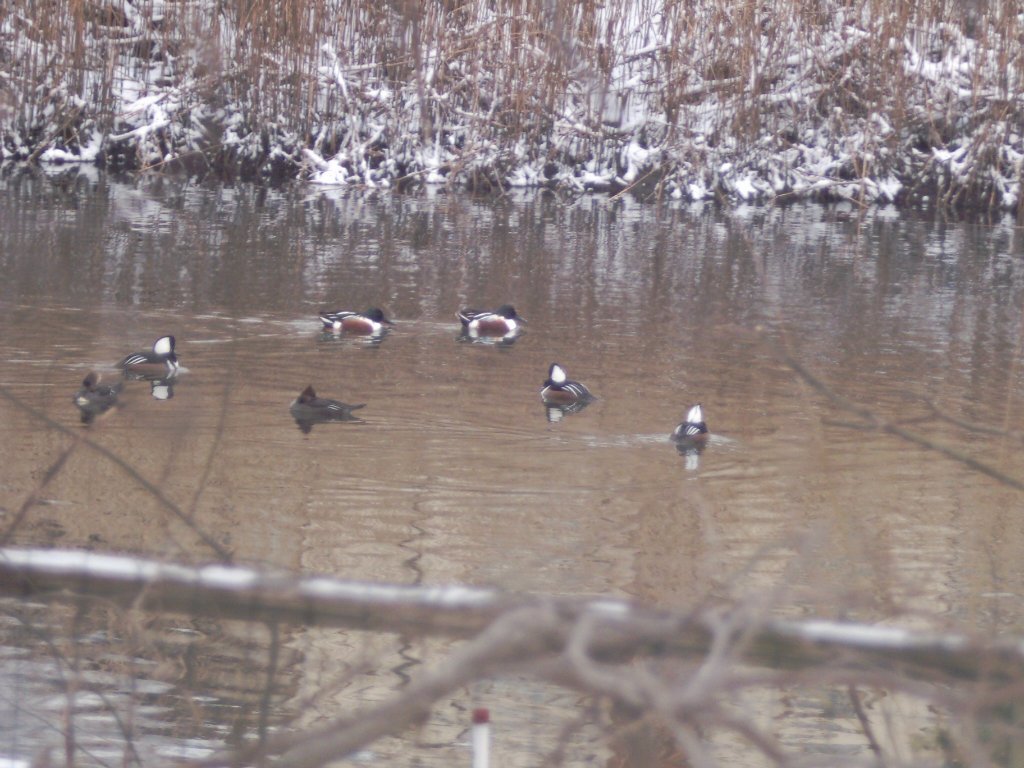
We dig up a field guide and we learn all about hooded mergansers, who have come to our creek for the winter. Who knows? Maybe they flew here from Lake Kushaqua in the Adirondacks. It’s possible. Doesn’t matter. On that quiet Sunday morning, Francis and Joan and I have a common purpose: Finding out what duck that is. It’s a nice, quiet little moment between the three of us in the midst of way too many noisy moments, and I feel like we’re starting to become friends, and the hierarchy is disappearing.
And if you’re wondering why my parents never noticed the hooded mergansers on their creek every winter until they were retired, you never raised five kids on civil service salaries.
Unstuck again. I’m in my thirties, and I’ve just recently met the woman I’m going to marry. A pretty bit of luck, that. It’s a Saturday afternoon in November, and we’re hanging out in my little bird’s nest apartment overlooking a six-lane highway in Lynbrook. I suggest heading over to Ancona Pizza on Rockaway Avenue in the Valley. Then, since I ended up meeting her parents on our second date (if one doesn’t count stalking her at the Island Park Train Station between the first two dates) I say, “let’s go over and meet my parents.”
And we do. We have a delightful little visit, and everyone likes everyone else. Trisha and I go out into the backyard. It’s dark and you can’t see the creek, but you can sense its presence. We both know three things at that moment: 1) These nice old people we just ate pizza with are selling this house and moving out east 2) We have fallen silly in love and will be together forever. 3) Even in the dark, this house and this yard look like they’ve seen better days.
While things are working themselves out, we do a little house shopping around Valley Stream and Lynbrook. We tour a horrible old house where we had to debate whether to call social services after we left, and several nice houses with teeny-tiny little postage stamp backyards and the house in back on the next street staring down on them in a constant surveillance operation, just like all my friends had in their backyards while I had a creek.
Two years and a month later, December 1, 2001, my parents have left the creek. Mom was not in fact dragged kicking and screaming as she declared she would be. She was making the best of it, not yet sick enough that she couldn’t hold court with new friends at the Jefferson’s Ferry Lifecare Community, where all the old stories could be rebooted.
Trisha and I are raking. She starts putting the leaves and yard debris into garbage bags. I say, “you don’t have to do that! Just throw it all down by the creek!” She looks at me like I’m crazy, one of thousands of times. It occurs to me that we have purchased waterfront property and there’s so much crap piled up and growing wild behind it that one can’t really see the water.

The following summer, I rent a dumpster with money we don’t have and pull 50 years of scrub and thug vines out of earth that we don’t actually own, on the strip of land between the backyard and the creek that actually belongs to Nassau County, like they give a shit. Howard the Rock and Roll Tree Guy comes around with mighty trucks and implements of destruction and cuts down all the dangerously dying trees that my dear parents ignored. Keeping one corner for what we rationalized would be a compost pile, but which has since just become a mountain of crap, I use the logs from the cut trees, wire fencing from the Home Depot and many, many cubic yards of dirt delivered from 1-800-TOP SOIL, carted via wheelbarrow from a giant pile in the driveway, to create a bulkhead, which I then separate at the property line with a retro post and rail fence so I can lean on it like a cowboy. I stock the bulkhead, which I dub “The Wetlands”, with native shrubs and the Famous Leaning Cedar Tree (which didn’t wash away in a hundred-year hurricane ten years later because my brother remembered all the boy scout knots I could never be bothered learning and he saved it by lashing it to the post and rail fence after it was half-uprooted).


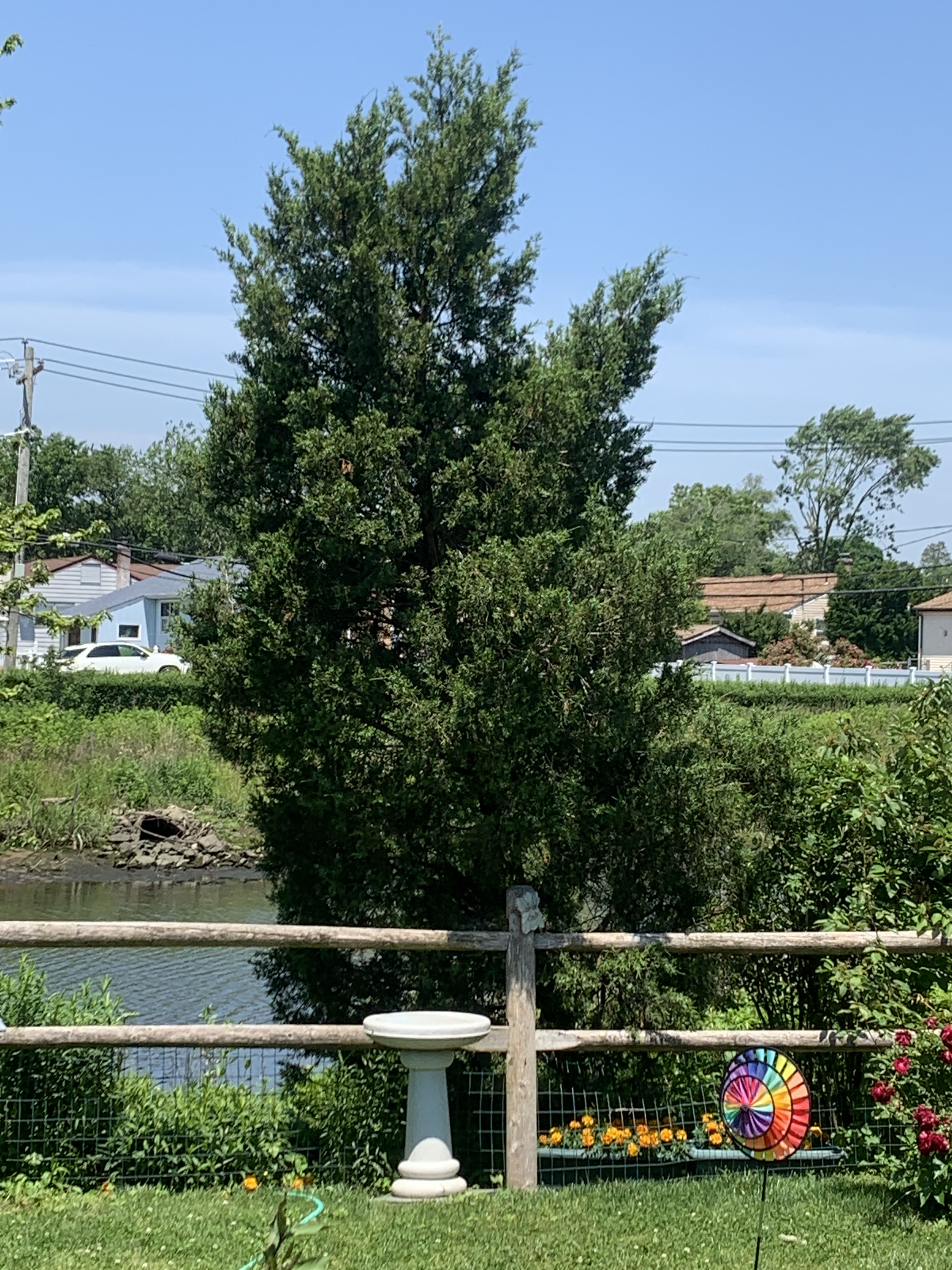
And thus began the Duffy’s Creek Bird Sanctuary, registered with the National Wildlife Federation in 2002 with the little metal signs and a certificate to prove it. And thus began twenty years and counting of being the warden, keeping it clean on my patch.
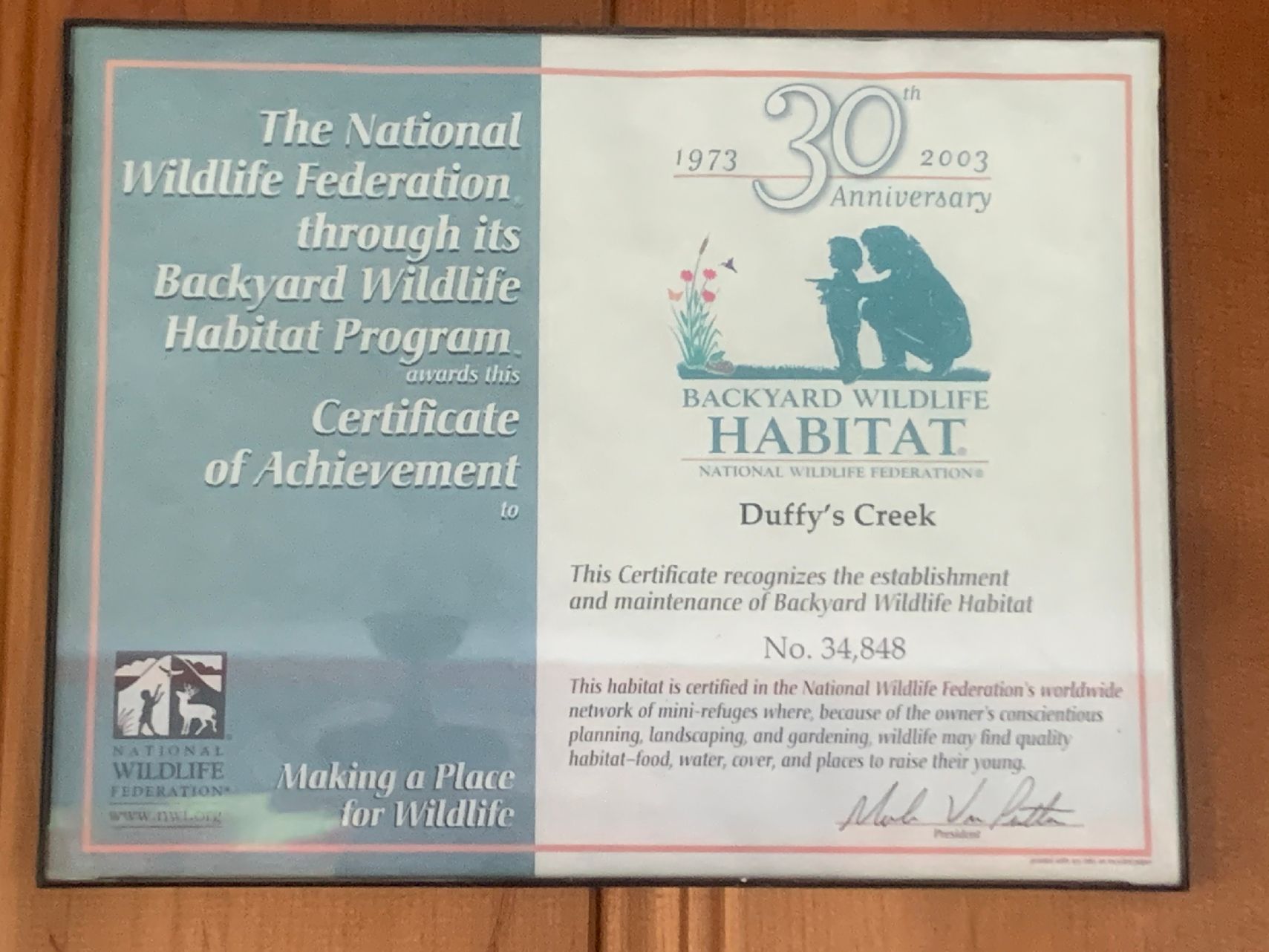

Unstuck in time again. I’ve reached my forties, set free to celebrate my inner nerd like nobody’s watching by the love and understanding of a beautiful wife. I have way too many bird feeders with way too much bird seed set up around the yard, and my work as a bird influencer has attracted over a hundred mallard followers, and likely a few rats. Among the mallards are always a group of larger, feral domestic ducks, most often white but sometimes looking like mallards that had been swimming around Three Mile Island when it melted down, hence the name of our current Problem Duck.
I had heard the white ones called farm geese or pekin ducks. In the awful, racist communities of South Shore Long Island, of which Valley Stream was most certainly one in the 60’s and 70’s but maybe a little less so now while others got worse, it was supposed by some, by way of a bad joke, that these farm geese or pekin ducks were on the menu at local Chinese Restaurants. Plus, the ducks were tamer than mallards, so along my creek, people let them wander around their backyards and fed them and gave them cute names.
People say and do all sorts of dumb shit, even relatively smart ones.
Two of my neighbors, one from Berkeley, California and the other from Hong Kong, were concerned because two of the farm geese or pekin ducks that they had grown attached to had moved across Mill Road to the Pond, and the spillway would prevent the ducks from getting back. So they decided to go rescue them. When relating the story to me, my neighbor from Hong Kong told me that he was well aware of the optics of a Chinese man running across Mill Road carrying a duck with a pillowcase over its head.
By the way, I’m pretty sure those two Farm Geese or Pekin Ducks flew right back to the pond. Thinking like a duck in that situation, I imagine I know why. Because fuck you, that’s why.
One day in that same era, a wood duck showed up for lunch with the mallards. Wood ducks are one of the most beautiful creatures in the whole wide world. @ me. This encounter leads me to purchase a wood duck house and a ten-foot wooden poll and install it at low tide because I’d seen little wood ducks diving out of nests in trees on PBS Nature and I thought I could get in on that. I never saw another wood duck, and it was probably a year later when I removed what had in essence become a squirrel house and piled it with the garbage on the side of the shed.

I like to think all of us learn and grow from these experiences. The beginning of my forties also coincided with my becoming a father, which thankfully left less time to plan dumbass ideas like installing a wood duck house.
It’s July, when they set teachers free. After a morning walk, I’ve parked my perfect sleeping baby boy in his stroller in a shady corner of the yard and pulled up a camp chair to sit next to him. In front of us are the red-twig dogwood and rosa rugosa shrubs I planted just a few years before, now the best little café in town for a pair of catbirds, my favorite songbirds. In a cloudless blue sky are terns taking turns gliding up and down the creek, hovering above us before diving spectacularly straight down to pick off some fishy lunch.
My son Jack has picked up some things from me besides cursing and surliness. He knows those birds now, too. All the cool ones. The kingfisher that rattles as he dives from branches over the creek. The little sandpipers and plovers that pick at the mud at low tide. The egrets and herons that seem to know just how cool they are. The day somebody dumped a domestic Toulouse Goose in our driveway, I suppose thinking that the poor thing would just make its way back to the creek and live happily ever after, Jack was instrumental in helping me to corral it into a pen until the two most cheerful people I’ve ever met in my life came to rescue it and send it to a farm in Pennsylvania.
Through the efforts of folks like these, I’ve learned that these domestic ducks really should be removed and relocated if possible. After exchanging a few messages with cheerful wildlife rescue experts about our Problem Duck, I’m told that they are waiting for someplace to put he and his co-conspirators, and not to worry, “your ducks are on my list.”
You’ve got a Hall and Oates song playing in your head right now, don’t you. It’s all good.
Actually, several factors besides the psychotic radioactive outlaw duck have combined to drive the mallards to breed elsewhere. Chief among them is that the reconstructed “Mill Brook Park” actually took out a whole lot of nesting sites among the phragmites, which we know by the name my father gave them: Woozy-woozies. Woozy-woozies are invasive, and the new plants along the path are all native. But try telling that to the mallards. They seem to have all said screw this place and flown down to North Woodmere park to find a decent place to lay some eggs. If we get two mating pairs of mallards in a summer now, it’s a lot.
There used to be hundreds of mallards on the creek in the winter, now at most there are dozens. In the early spring, you could observe the mallard mating ritual almost every day. This is when the male circles the female repeatedly while bopping his head up and down ridiculously until he gets the OK to climb on top of her. I used to see this a lot at the clubs back in the 80’s, too. Usually Depeche Mode would be playing.

By early summer, there’d be lots of mallard babies. Of course, ducks have lots of ducklings because many ducklings become lunch for hawks and snapping turtles and don’t get to grow up to have ducklings of their own. Circle of Life and all that. But I always got too emotionally involved with the whole thing. Counting four of them on a Tuesday after counting six on Monday was always kind of a buzzkill. Still, there’s nothing goddamn cuter than a duckling.
We still get the hooded mergansers every winter, and they always make me happy. If we ever needed a Duffy’s Creek logo, it would be a hooded merganser. Just ‘cause they’re so damn cool. But we used to get a lot more winter ducks before we screwed up the climate; common mergansers, northern pintails, redheads, common goldeneye, green-winged teal. In the first weeks 2004, while we were waiting for a baby to be born, the whole Northeast was locked in a bone-chilling, sub-zero cold. Trisha and I were at the picture window picking off new ducks every weekend. This past winter, we had a pair of buffleheads in for a few weeks. I couldn’t remember the last time I saw them, but it was sure great having them here.
Then there’s the mysterious ruddy duck. I thought he had finally found himself a girlfriend last winter when I saw a pair for the first time. But then a second male showed up, making three ruddy ducks. I figure one would have to become the third wheel in mating season. I remember that shit. But my ruddy duck always seemed to be living his best life regardless, often spending the whole summer here by himself, living among the mallards like he was in some sort of duck witness protection program.

I can tell you that the oldest ruddy duck on record was 13 years and seven months old and my ruddy duck has been hanging around here for at least ten years. He’s not here this summer either because he finally went under the Rainbow Bridge or because Three Mile Island ran him off. But that’s part of the wonder of the creek. I might look out the back window tomorrow morning and see my ruddy duck swimming and diving around like he never left.
Besides the Hoodies, one other bunch of regulars still come around, the northern shovelers that look like mallards with big beaks. They don’t laugh like mallards. They have tiny little quacks, if they speak at all while they’re here. They hang out with the mallards and the freak feral ducks, but they don’t get involved in their drama. They always look like they’re consciously trying to mind their own business. They float and they dive around on my creek for the winter, then they fly back to Ontario and Quebec, and they don’t need to explain anything to anyone.
Nor do Henry and Henrietta, who also have to take some of the blame for the missing mallards, but they clearly don’t give a fuck about ducks. Technically, they are the great-great-great grandchildren of Henry and Henrietta. Those are the names that my mom gave to the mute swan pair that showed up on her creek one spring. Watching swans gliding down a creek while you sit in an Adirondack chair in your backyard is one of those experiences that led my father to say that living on Duffy’s Creek “was like being on vacation every day.”
If Mom knew that mute swans were bullies that push other species out of habitat, it wouldn’t have mattered because Henry and Henrietta were beautiful. And so are their ancestors who still grace our creek. I give them credit for running off the Canada Geese that took over for a couple of years. They were terrible neighbors, almost as bad as the people from Suffolk County who used to live next door. The swans don’t chase every mallard off the creek like Three Mile Island has been doing, but they kept a lot of real estate for themselves when they were breeding.
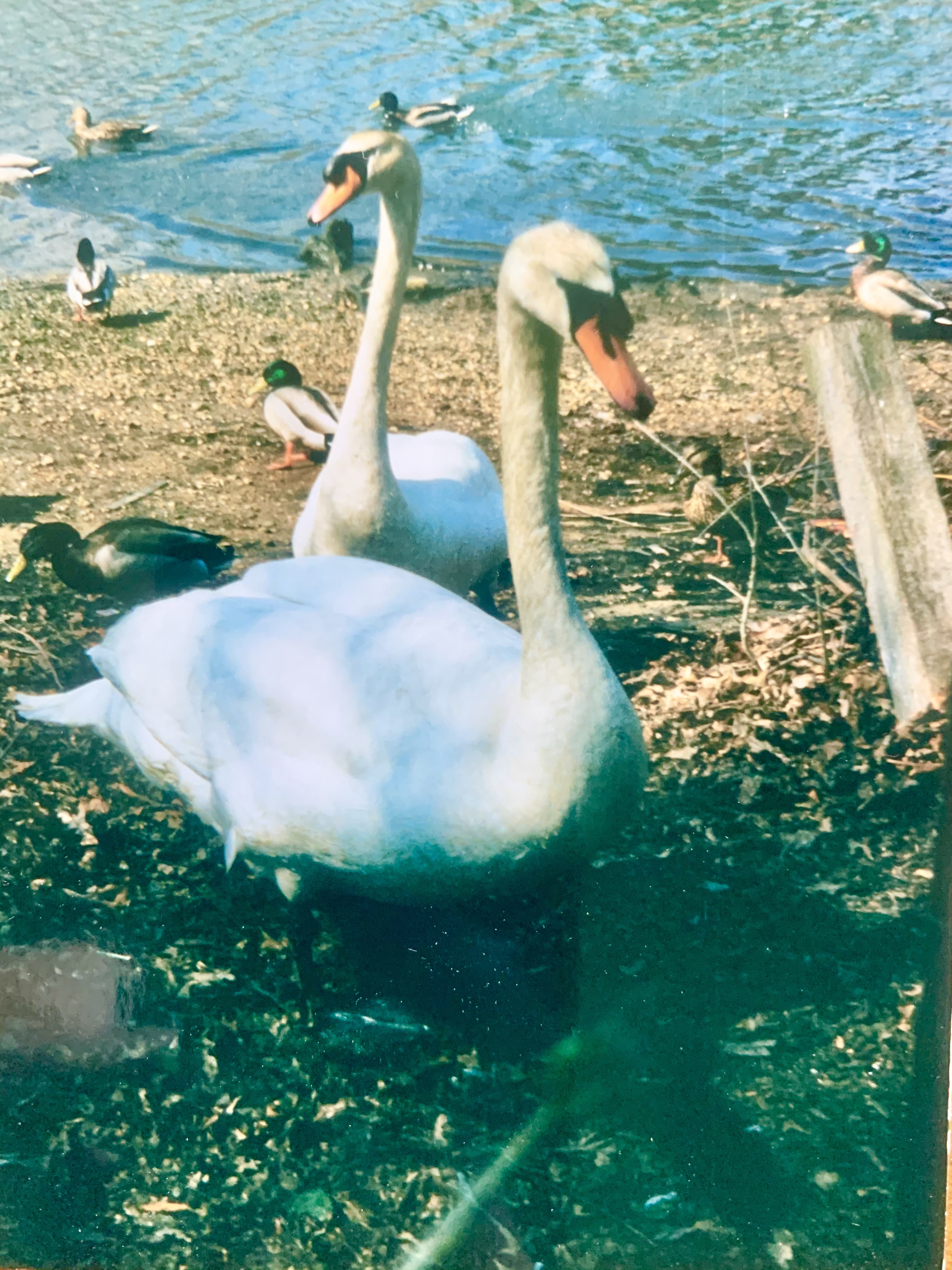
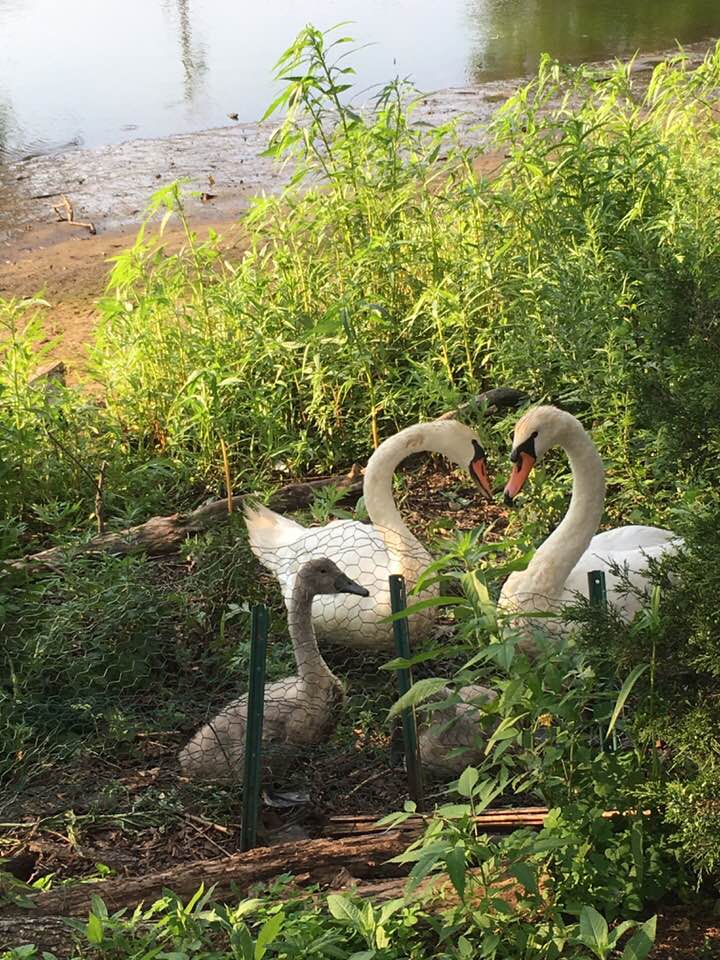
This year, the swans are just hanging out. No nest, no cygnets wearing trumpets and blackboards around the neck or otherwise. The State DEC has been at war with mute swans for years, so maybe they were sterilized somehow or had their eggs addled, although you can’t miss a swan’s nest and there isn’t one this year. So even though its clearly psychological projection, I think it’s more likely that they are past their breeding years and just enjoying the creek.
Traveling unstuck through years of waking up at quarter to five and slogging west on the Belt Parkway, Ol’ Man Creek, he just kept rolling along. Whenever I could, I’d sit there and watch him flow, no matter what got in the way and which way the wind did blow. He scared the hell out of us in Hurricane Sandy and he grosses us out when algae blooms and droughts make him look and sometimes smell like an open sewer, but mostly he’s been a benevolent neighbor and friend, rising and falling with the tide, reflecting I’m Not Happy’s klieg lights at night, forever wild as the rest Valley Stream groaned under the weight of civilization.
Although I currently have a first world problem regarding kayaks and the current condition of the water. The algae and the various unidentified crap floating about has been particularly bad this spring, despite the hack who told you in Newsday last fall that the water was getting cleaner since the path was renovated. Not quite yet and maybe not in my time, although it just smells like the creek and nothing worse. But I generally don’t feel great about paddling a boat in any water I’m not theoretically prepared to fall into, longshot though that is.
My father contracted polio in the late 1950’s. He was probably saved by Jonas Salk’s vaccine. He theorized that he might have contracted the disease from swimming in the creek when he first bought the house in 1955. A local fellow used to swim in the creek all the time when I was a kid in the 70’s. As far as I know he lived and thrived and took showers. One way or another, it’s not a particularly dazzling experience to paddle a sit-in kayak through dirty water, although as the creek winds its way through backyards southwest of Big Brick, it is sort of like paddling through the bayou, except with people pointing cell phones at you.

Meanwhile up north, there’s at least five beautiful lakes and ponds within a half hour of Trisha’s Mountain, two of which are New York State Parks that have boat rentals, but our boats are much nicer than theirs. With the exception of Hempstead Lake, where one can enjoy a stunning view of road rage incidents on the Southern State Parkway, the best paddling spots on Long Island are all an hour or more away in Suffolk County. Yes, Nassau County is surrounded by water, and yes we have paddled the South Shore Bays without incident, but the currents and the wind can get a little wacky on the open water. And when we’re out there, I spend a lot of crucial brain cells wondering where the hell people got the money for these houses and dreading a Long Island encounter with an unrepentant asshole on a jet ski.
I like mountain lakes. Ponds, too. Preferably with no motors allowed.
So, you say, why don’t you just take the kayaks with you when you go upstate? Well, The last time the kayaks went north on the top of Lou the Subaru was when the transmission exploded on the Adirondack Northway. (You can scare Trisha just by saying “Queensbury!”). And while I don’t believe that this will happen again, the day when I haul the boats up through the wind tunnel of Interstate 684 and up Route 22 to The Mountain will be the end of having kayaks on Duffy’s Creek, ‘cause once I get them up there, they ain’t coming back. Currently I’m on pace to spend about 82% of this calendar year on Long Island, which statistically means more days when all the stars line up with the wind and the tide and we can bring the boats somewhere. Meanwhile, people at the State Parks are very nice even if their boats are not so much.

Photo stolen from Trip Advisor without permission.
Again, this is all a first world problem so embarrassingly pretentious that I have no choice but to laugh at myself, just like the mallards taught me. But still. It would be nice if I didn’t have to think twice about paddling on my own creek, and nicer still if Nassau County hadn’t blocked me from another couple of miles of paddling through Hook Creek towards the bay.
Then again, I also have to drive my Labrador Retriever 118 miles to get in a decent swim, and in between trips, he sits and stares at water that may as well be molten lava for all the good it does him.
Yes, Duffy’s Creek is truly a wonderland of flora and fauna. But for our purposes, it’s become mostly decorative.
I’ve returned to the present tense. I’m pushing sixty. I’m in week four of a longer than usual six-week Creek stretch before my next ten days up on The Mountain. Despite my advancing age, I’ve spent lots of my bottomless pot of free time out in the hot sun whipping the gardens into shape, cleaning and polishing two expensive kayaks that haven’t touched a body of water yet this year, painting a bench blue because I felt like it, training the Mandevilla to crawl up the giant decorative metal sun that I bought on Amazon to replace the smaller one that got old and broken, proudly admiring my purchase of a wonderful bit of kitsch that can be seen from the path on the Left Bank, and possibly from space.

I’m sitting on the patio with Trisha and It’s a nice night to be here. “It just could not be better,” as Bob Murphy would say of a good night for a ballgame at Shea. The ferocious, ozone-laden heat of the day is abating. We wouldn’t be able to escape it even if we were on The Mountain. My rectangle tells me that it’s just as hot if not hotter up there. And as my father pointed out to me, the Atlantic breezes reach South Valley Stream about 5 o’clock in the afternoon. They never reach Copake Falls.
The sun is setting, and while The Show is limited by our sea-level elevation and all the houses in the way, the sky is turning all sorts of deep funky purples and oranges and reds. The crazy perennials in the patio garden haven’t reached six feet high yet, so we’re still watching our fellow Streamers on the path over in “Mill Brook Park”, keeping a running commentary on their gaits and their wardrobe choices.
Just like that, a bald eagle glides low along the creek right in front of us. More than likely the same bald eagle that Jack caught a picture of when he visited us the day before the last Presidential Inauguration. He (or she) is an absolutely majestic creature, and even though we worry that a bald eagle might steal territory from our old and dear friends the ospreys, there’s no denying the jaw-dropping beauty of those huge prehistoric wings silhouetted black against the setting sun.

Yup. My father would have told you that living on The Creek is like being on vacation every day. That’s a good line, and tough to beat. But in that moment, as a bald eagle cruises by like he owns the place and we both realize what we’ve just seen, I say something to Trisha that we’ve said to each other hundreds of times since we first read it to our son in a book by the weird and wonderful Margaret Wise Brown (of Goodnight Moon fame) called Sneakers the Seaside Cat. The story is about a cat that gets to spend a day exploring at the beach. Every time Sneakers sees something cool, she thinks a thought that I’ve thought tens of thousands of times while looking out on the creek, MY creek, where things are always changing with or without me.
And I say this thought out loud to Trisha right before she would have likely said it to me. It’s the same thought that will sustain us both on the day when we’re dragged away, not kicking and screaming, ‘cause we have somewhere really nice to go to.
And it’s even the same thought I had right smack today in the here and now, when Trisha called me out from the air conditioning this afternoon to see a flock of thirty terns circling overhead, no doubt the distant relatives of those terns I watched while our perfect baby boy slept in his stroller, as all thoughts and all moments exist simultaneously.
Sneakers the Seaside Cat thought to herself, “my, I’m glad I saw that!”
Copyright 2021 by John Duffy
All Rights Reserved
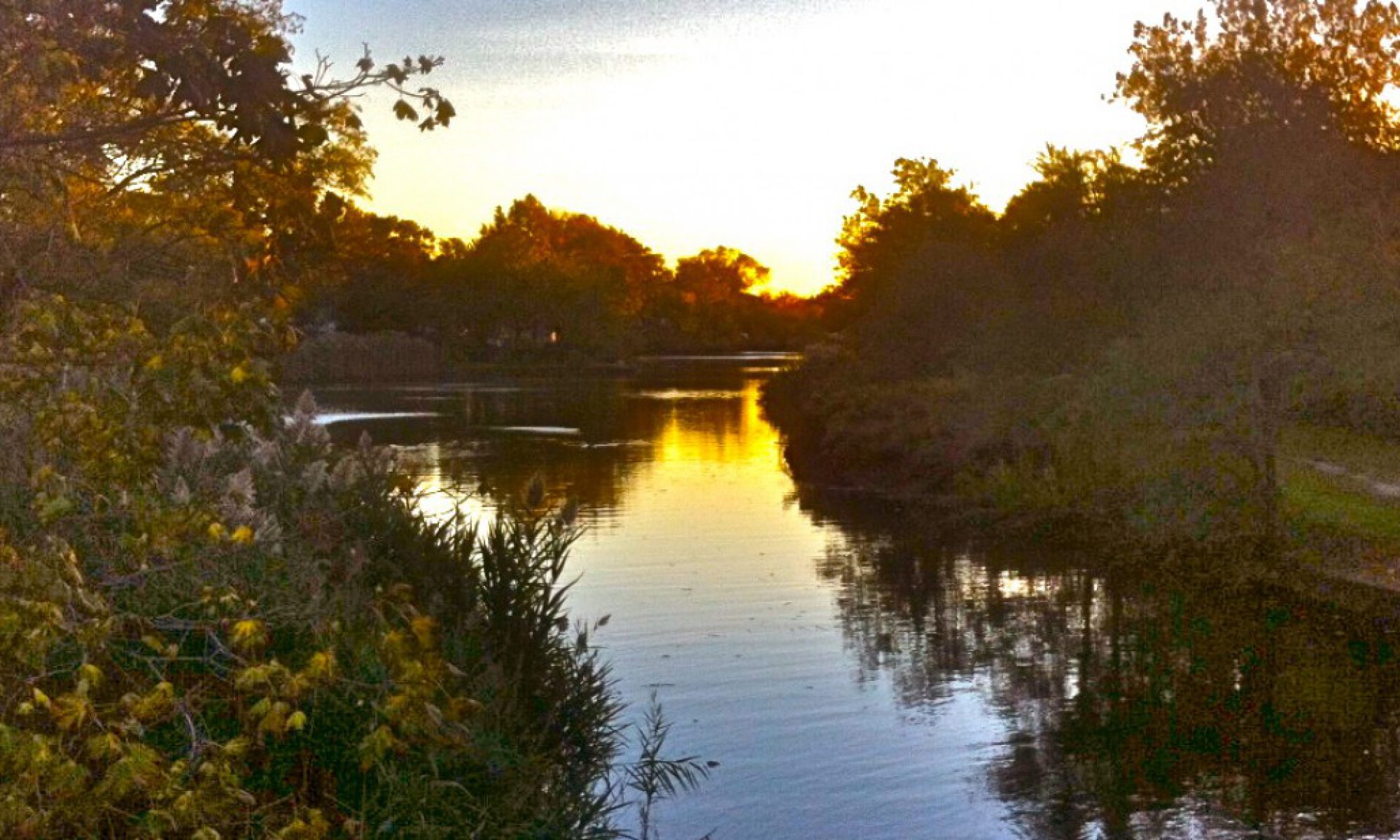
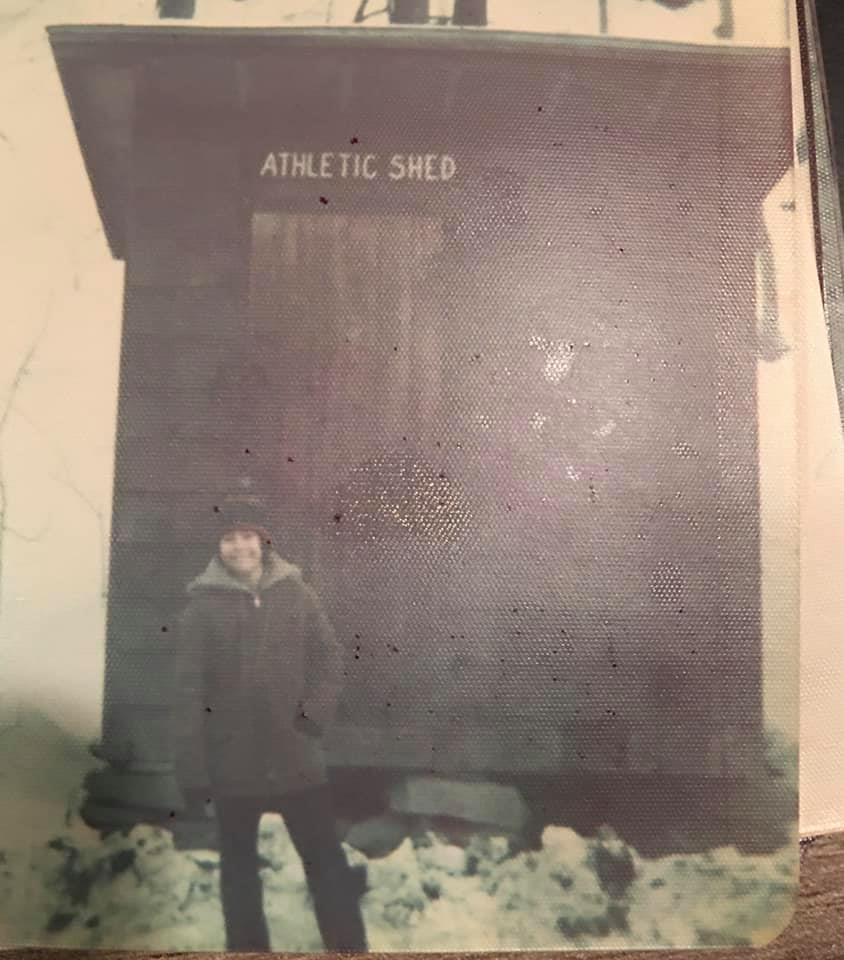







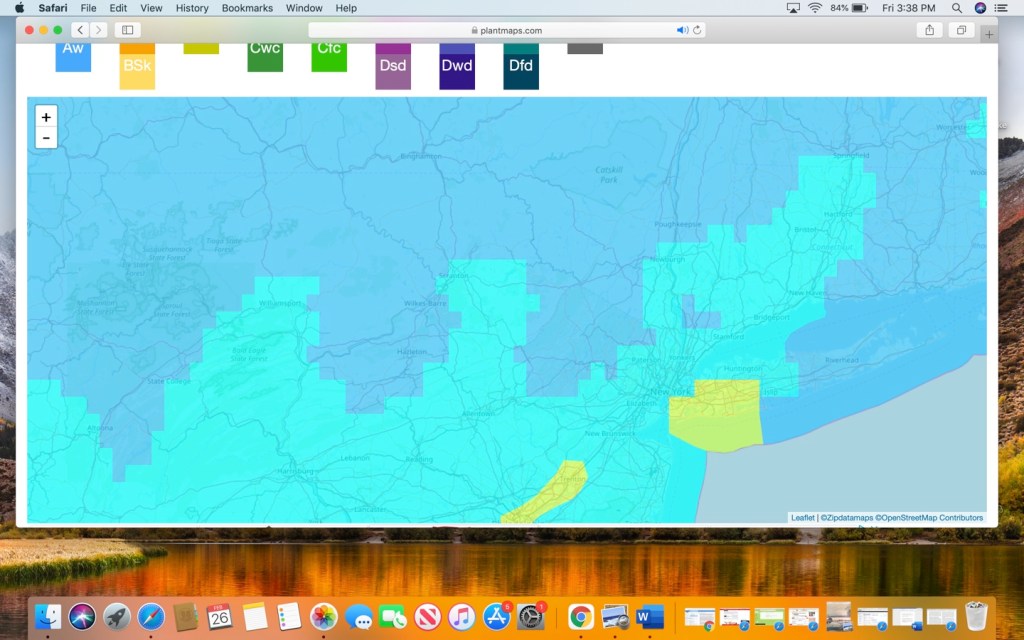


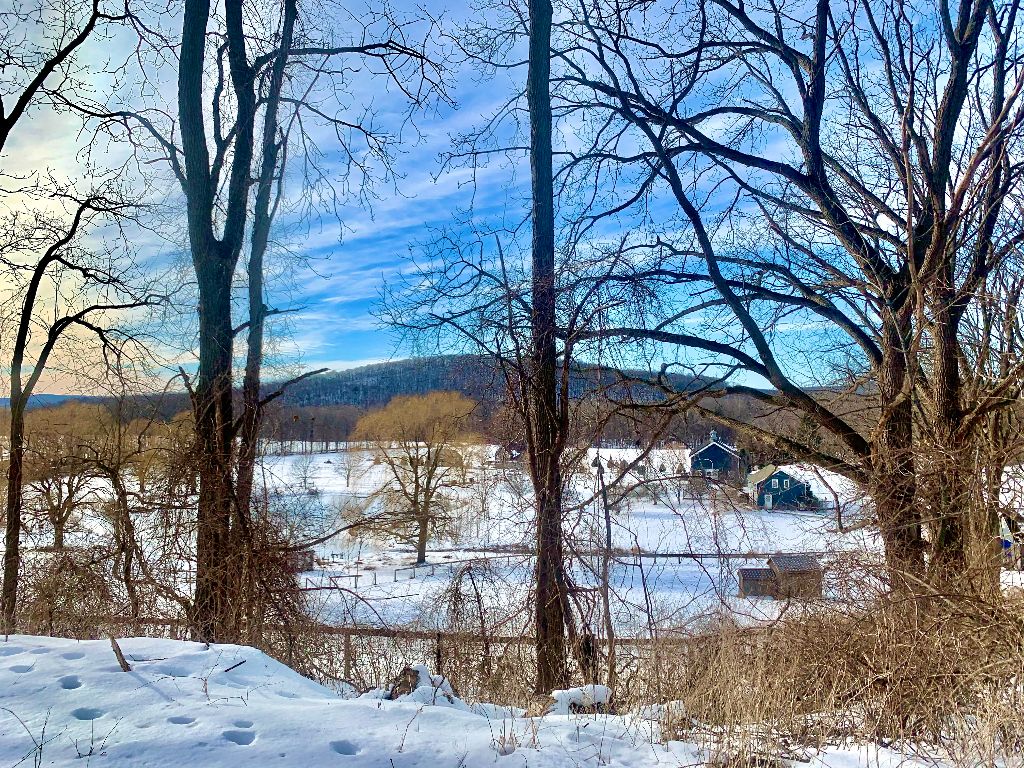


















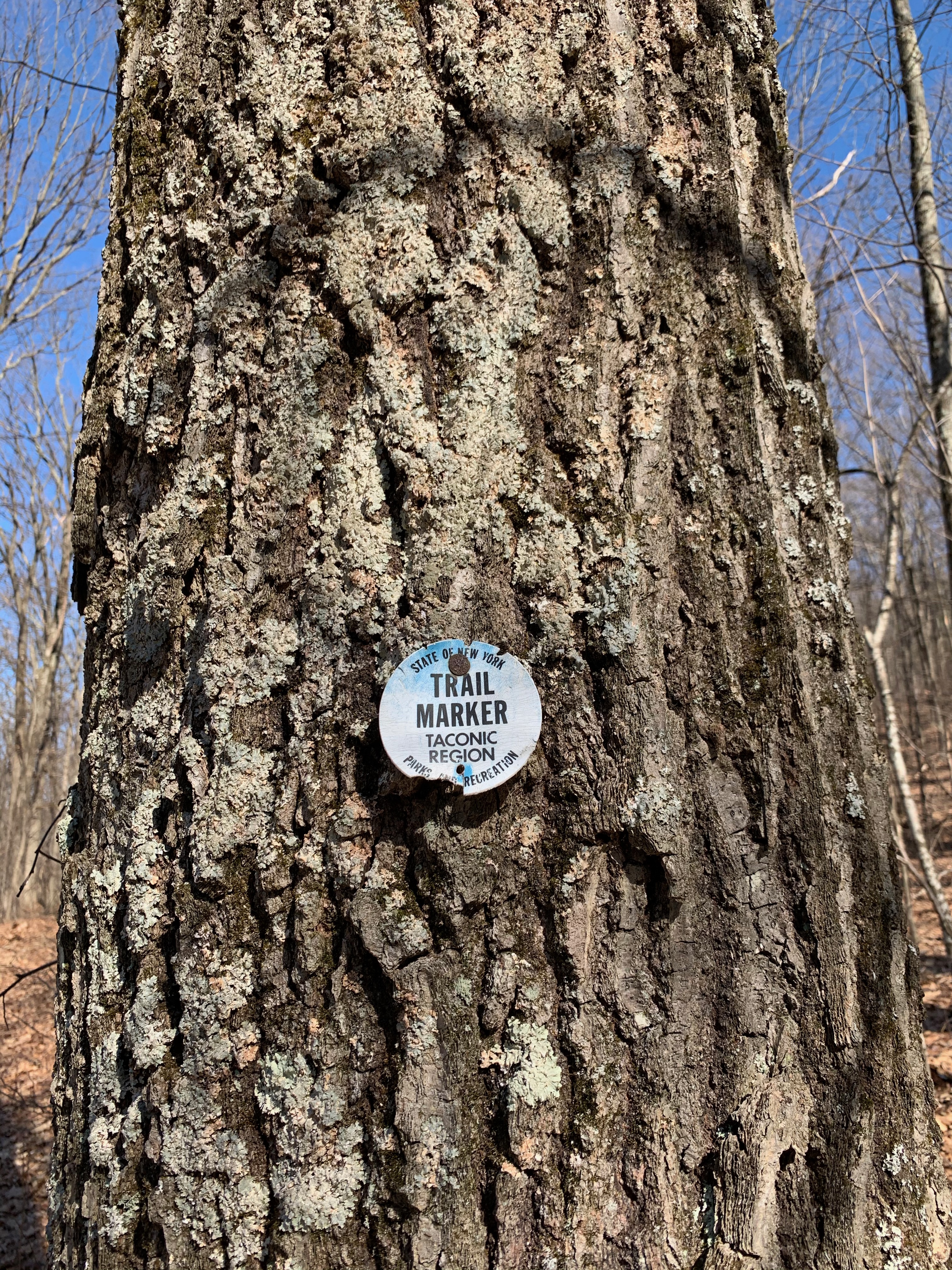

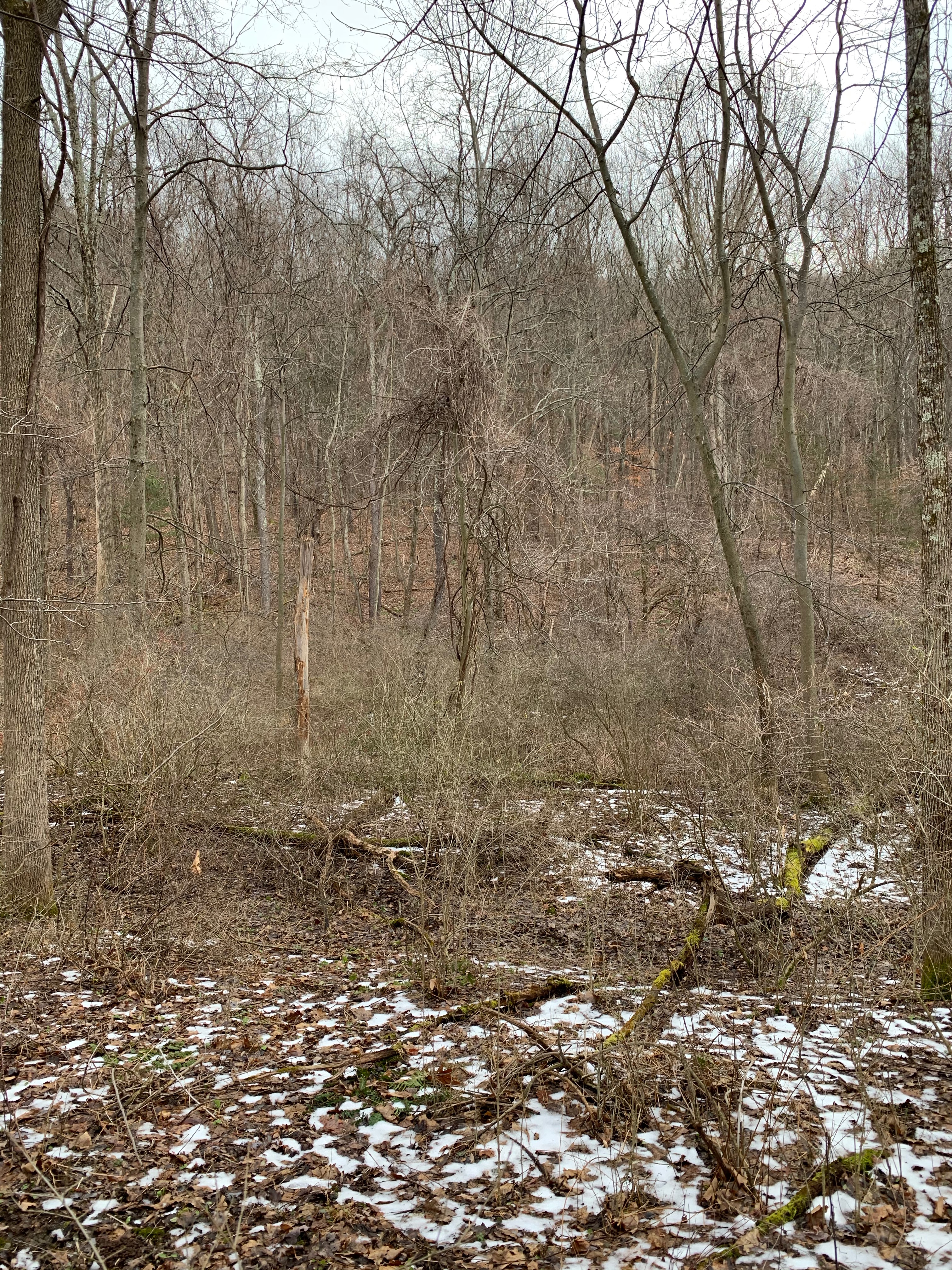

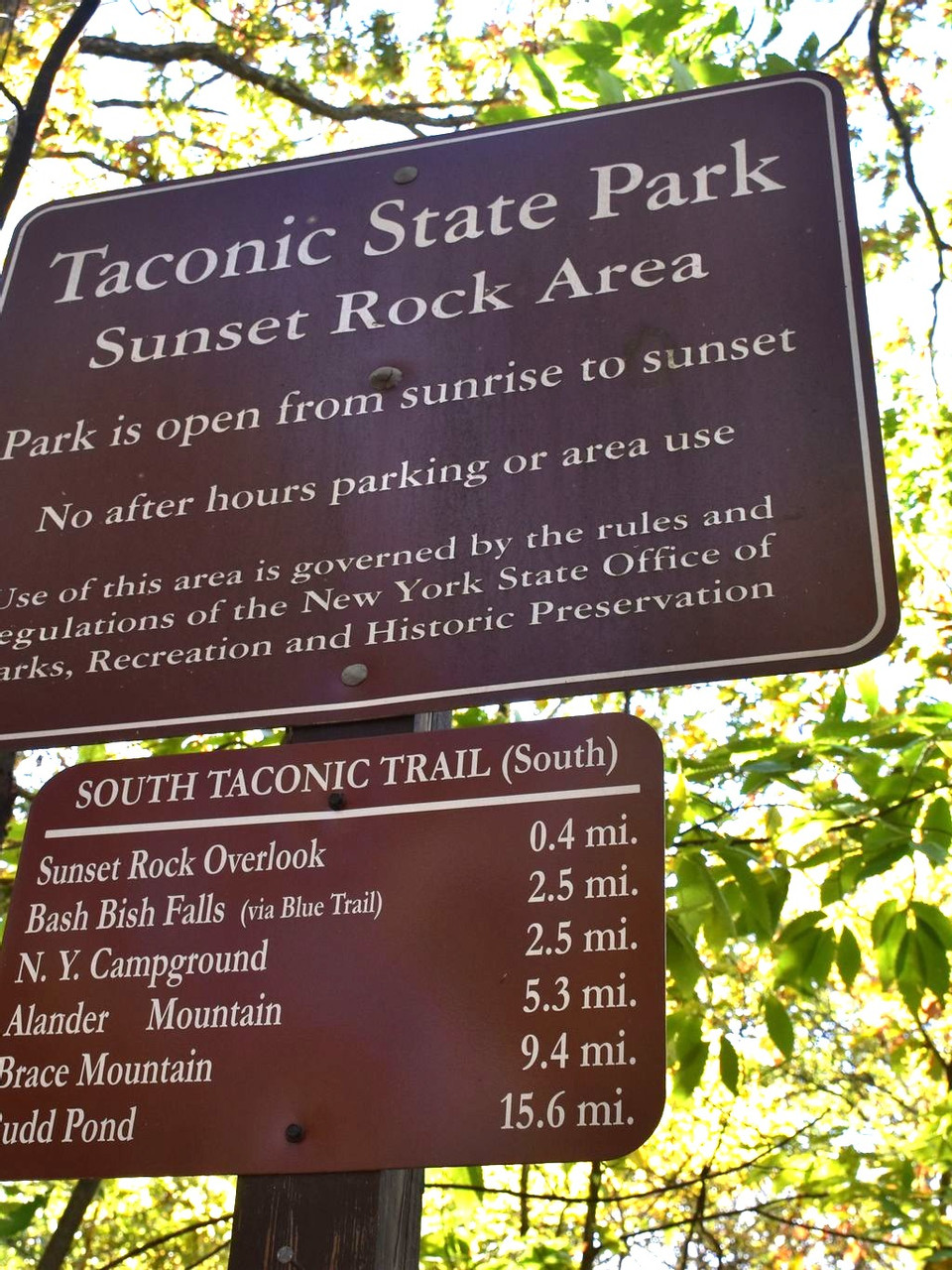
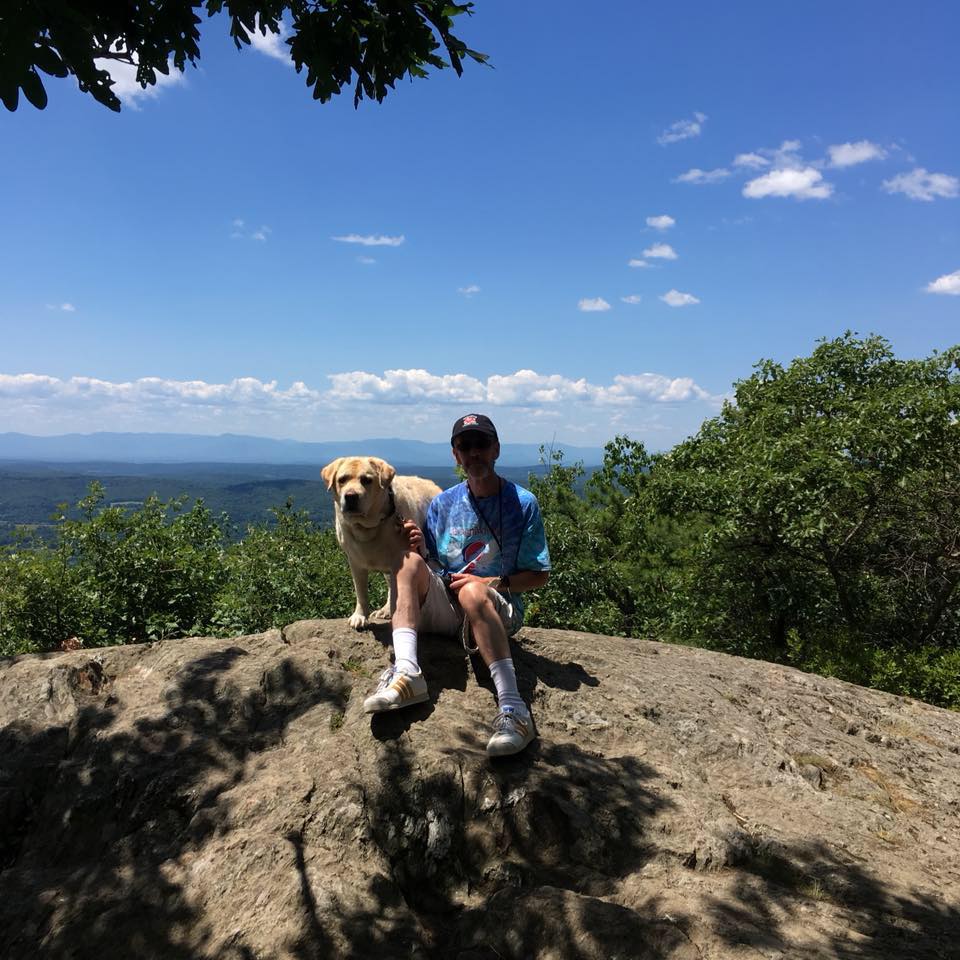
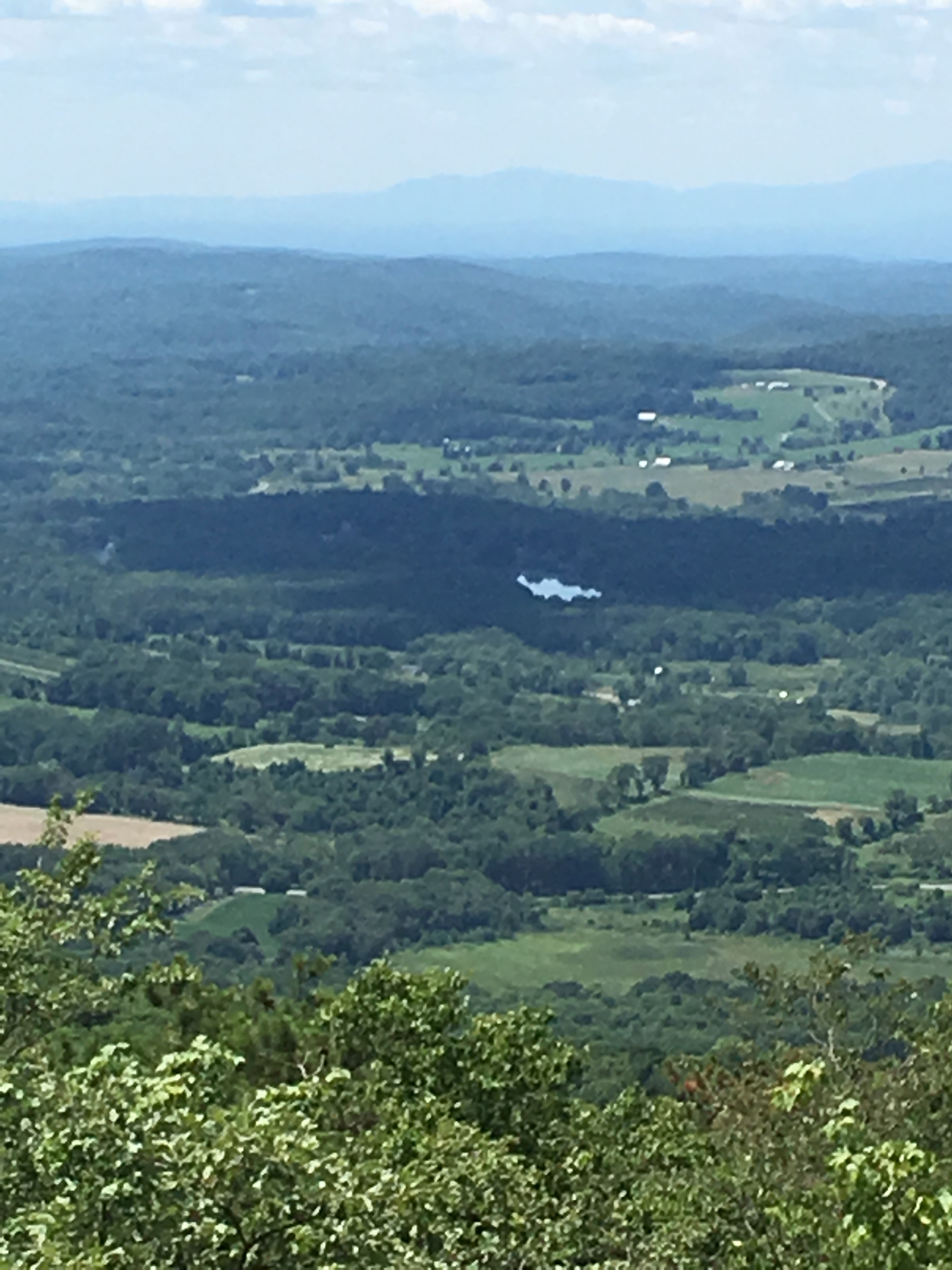

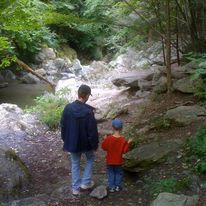



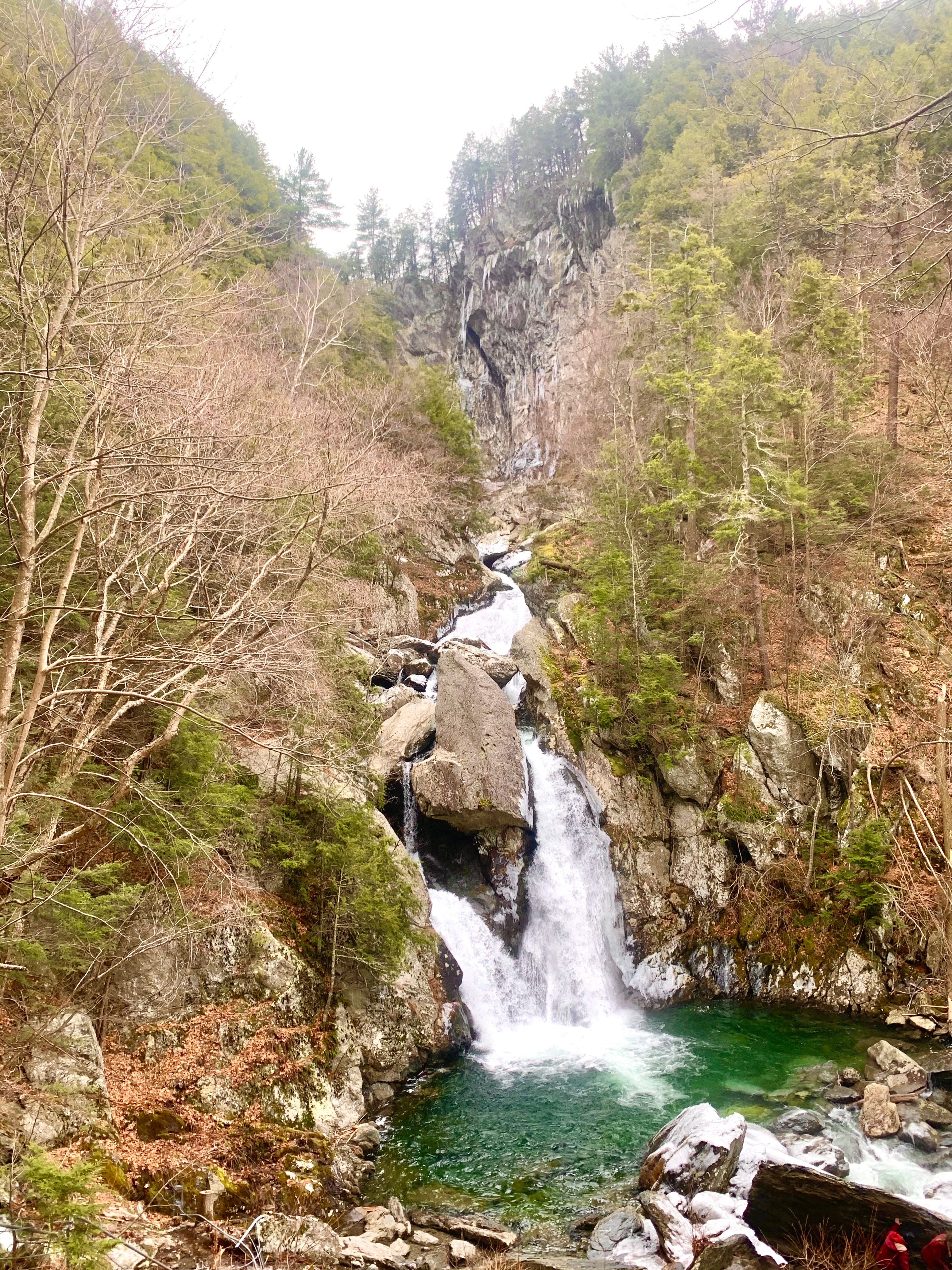








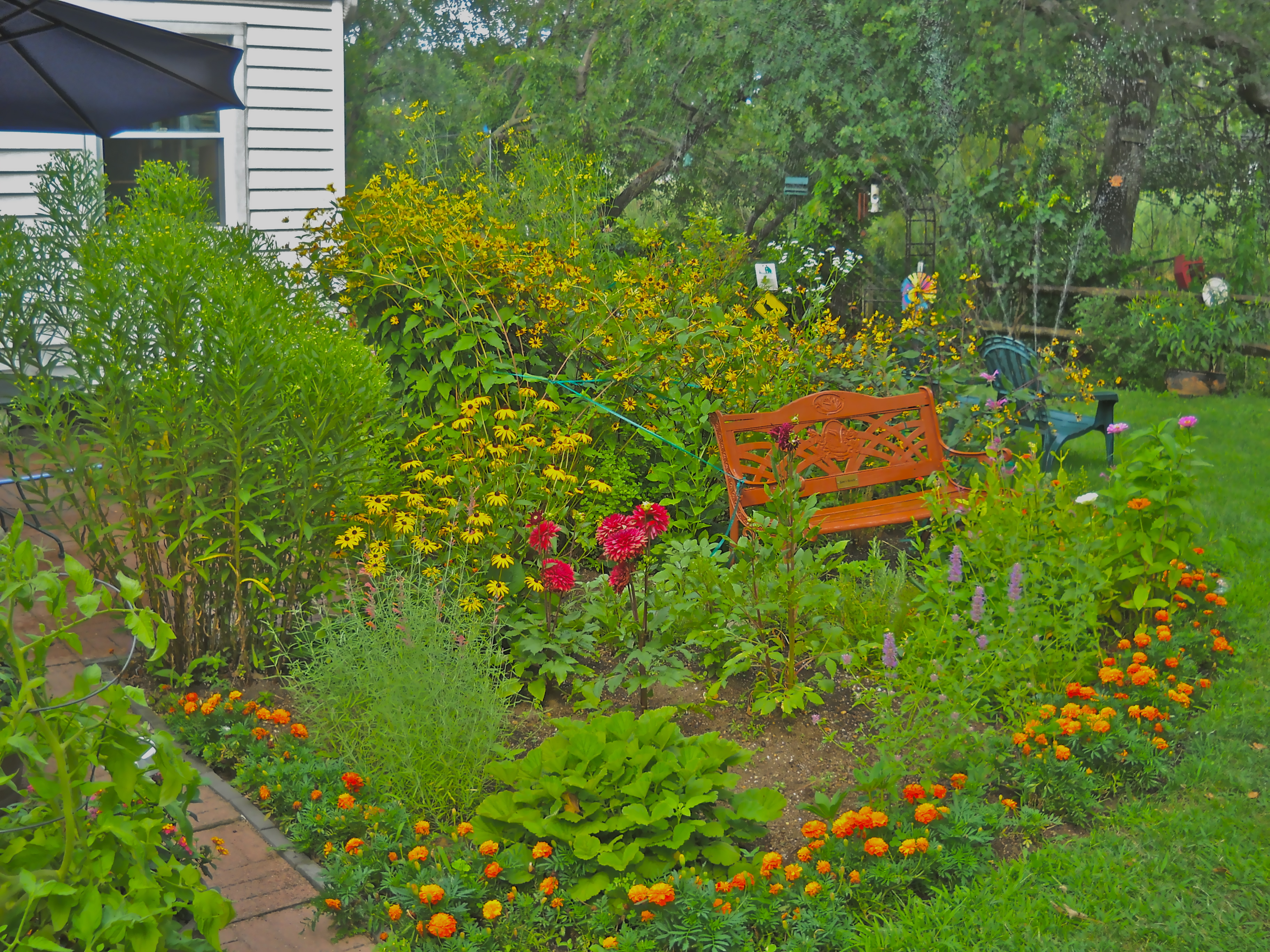
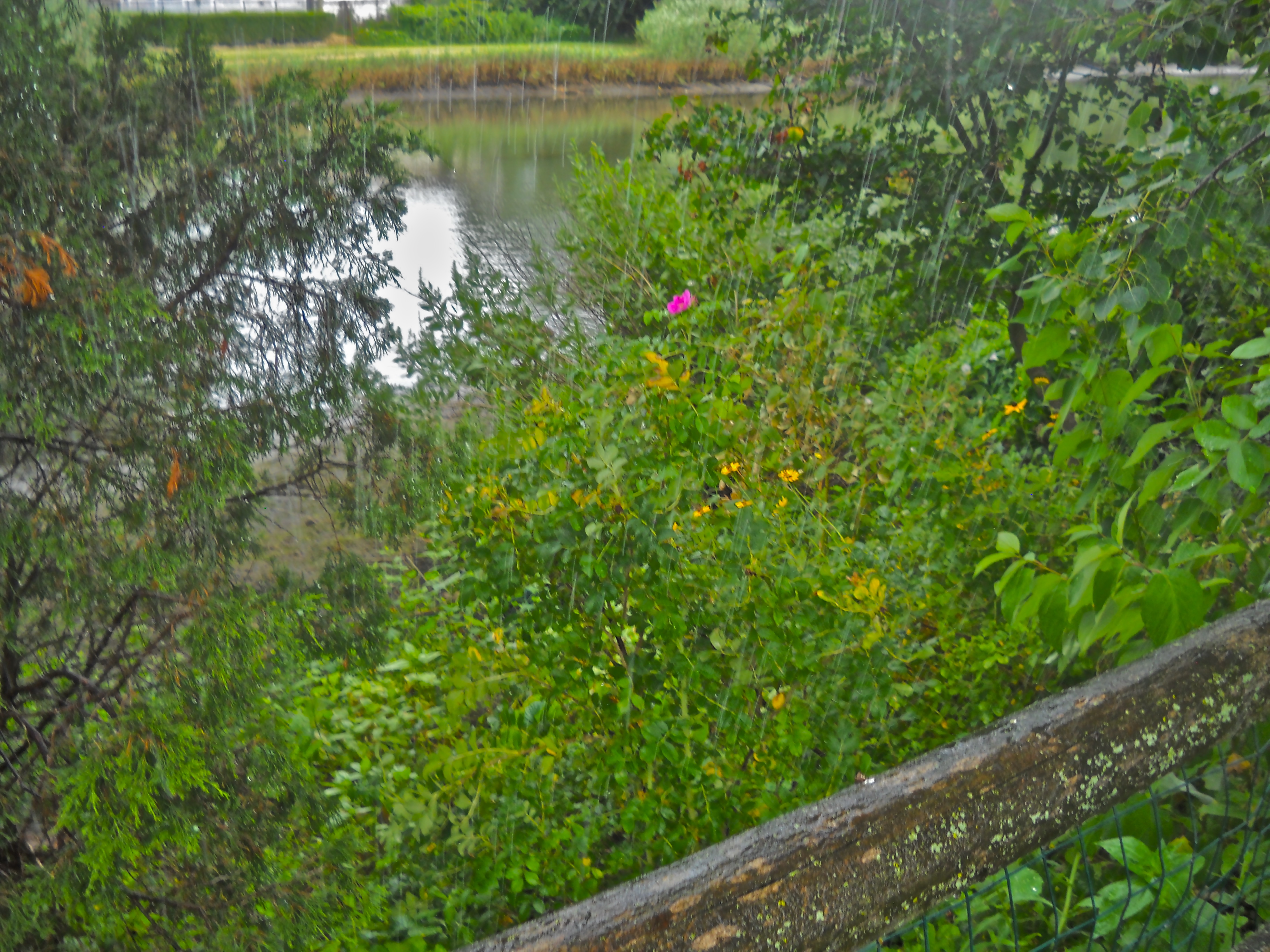

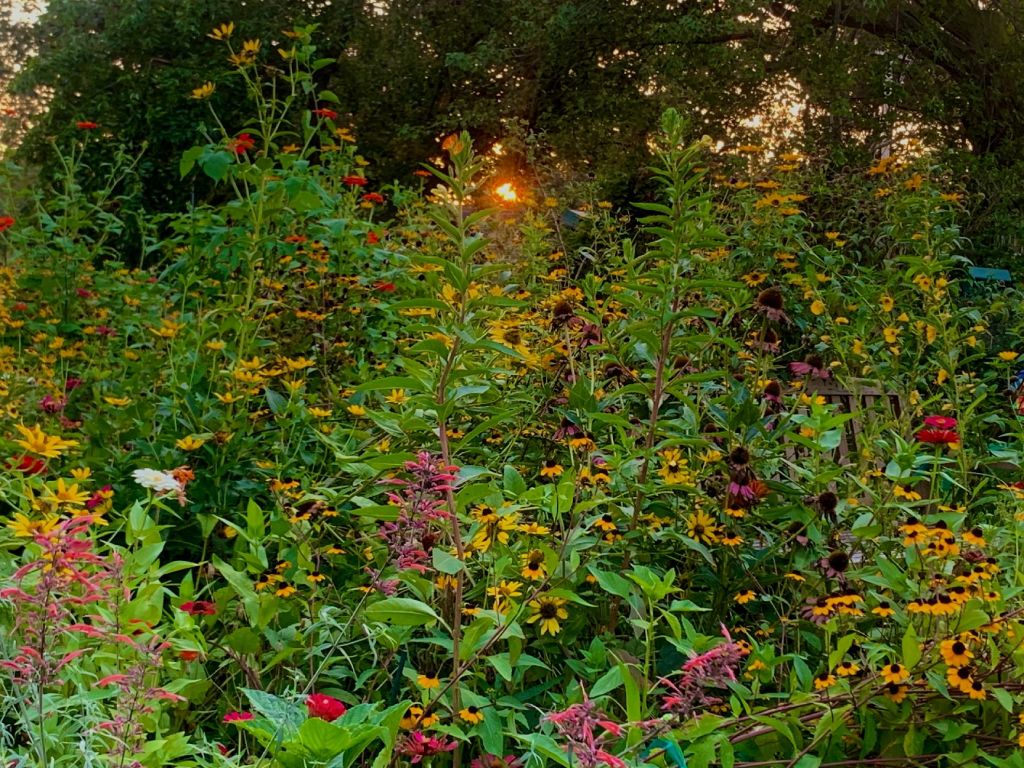



















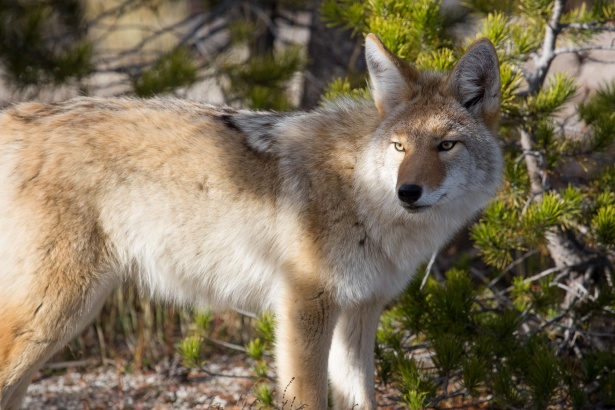


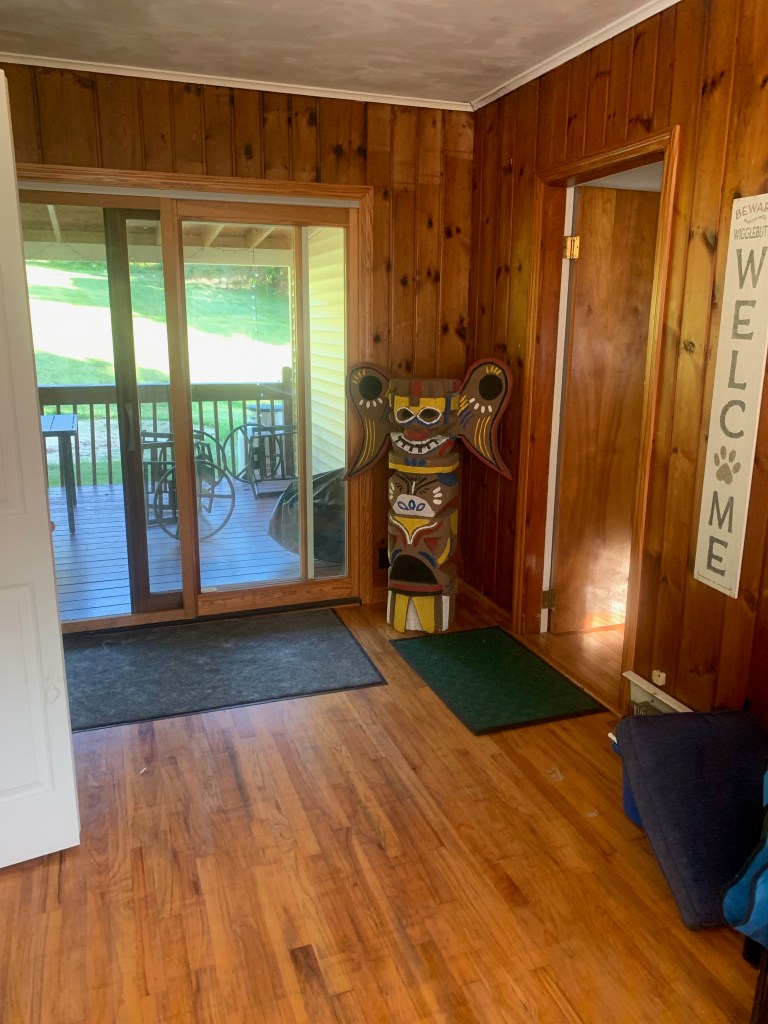







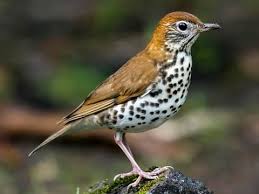


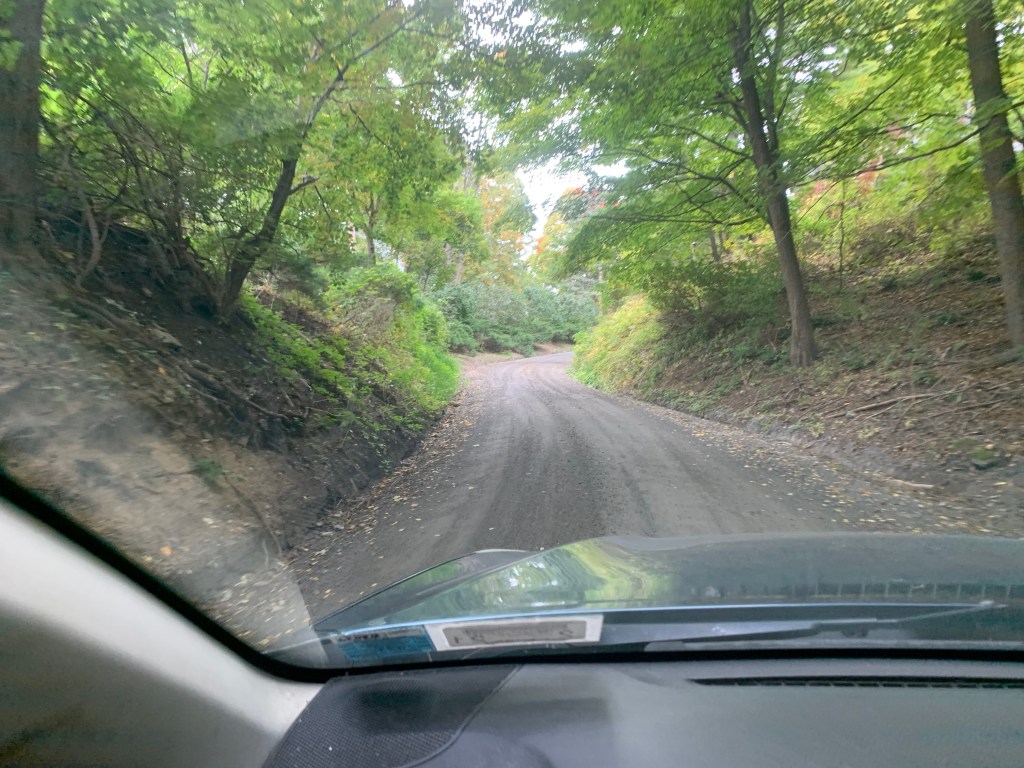



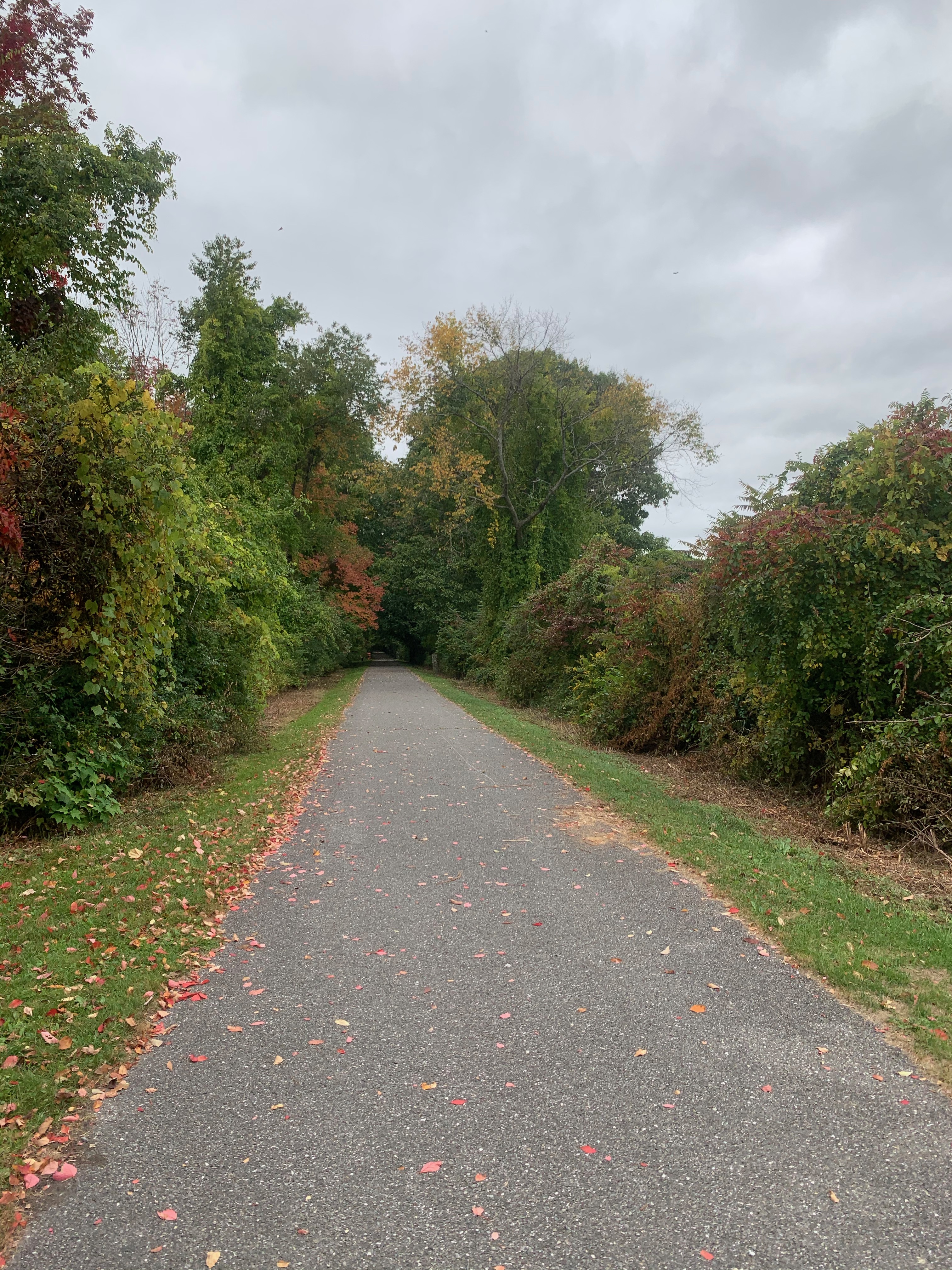


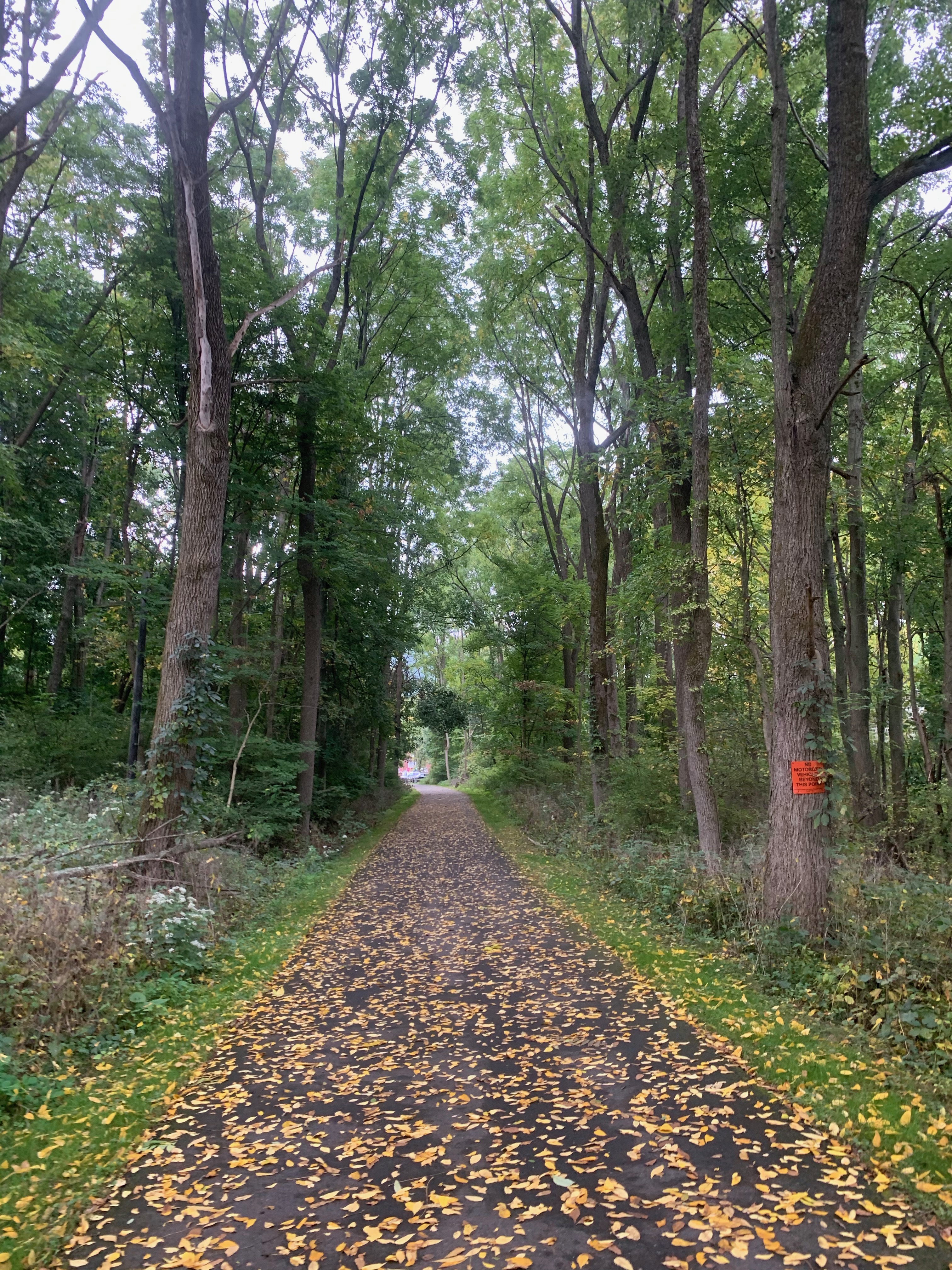



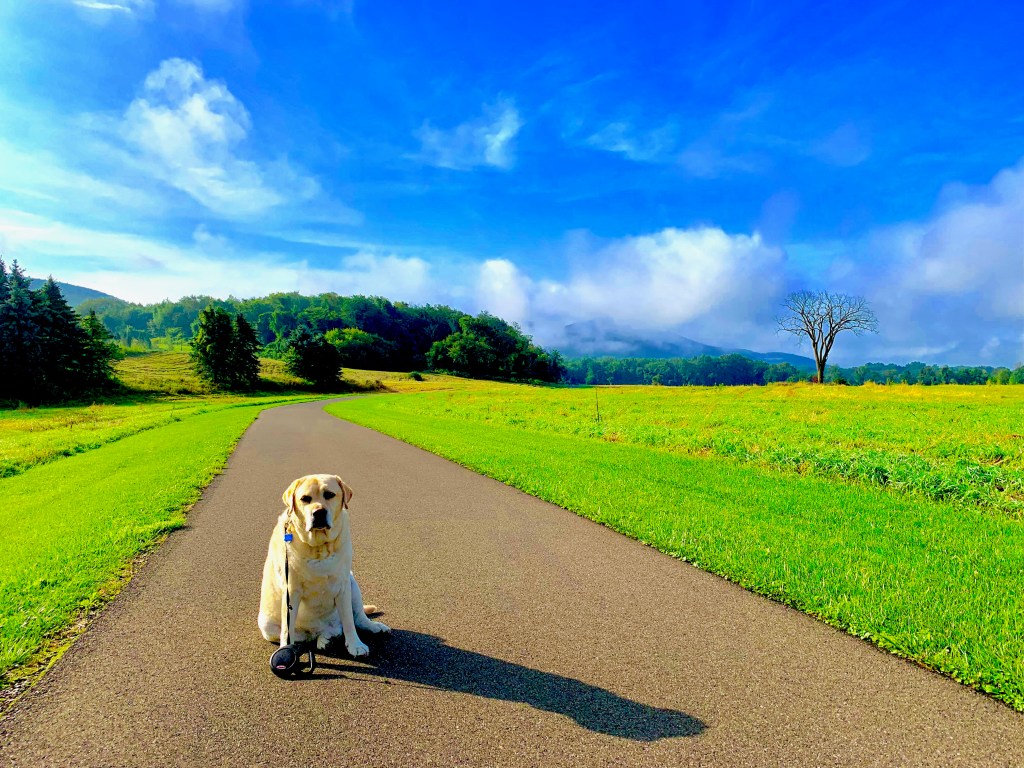



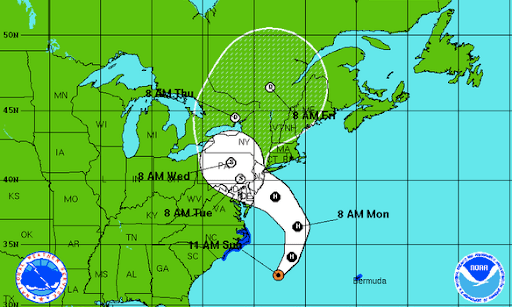
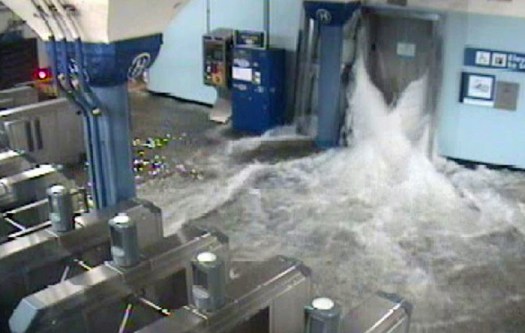



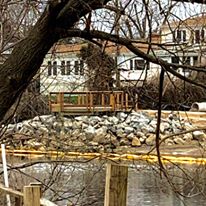
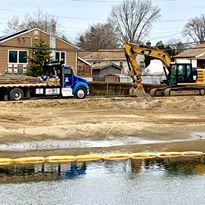



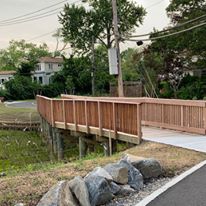



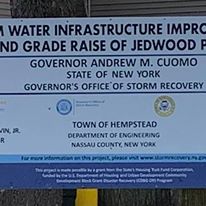








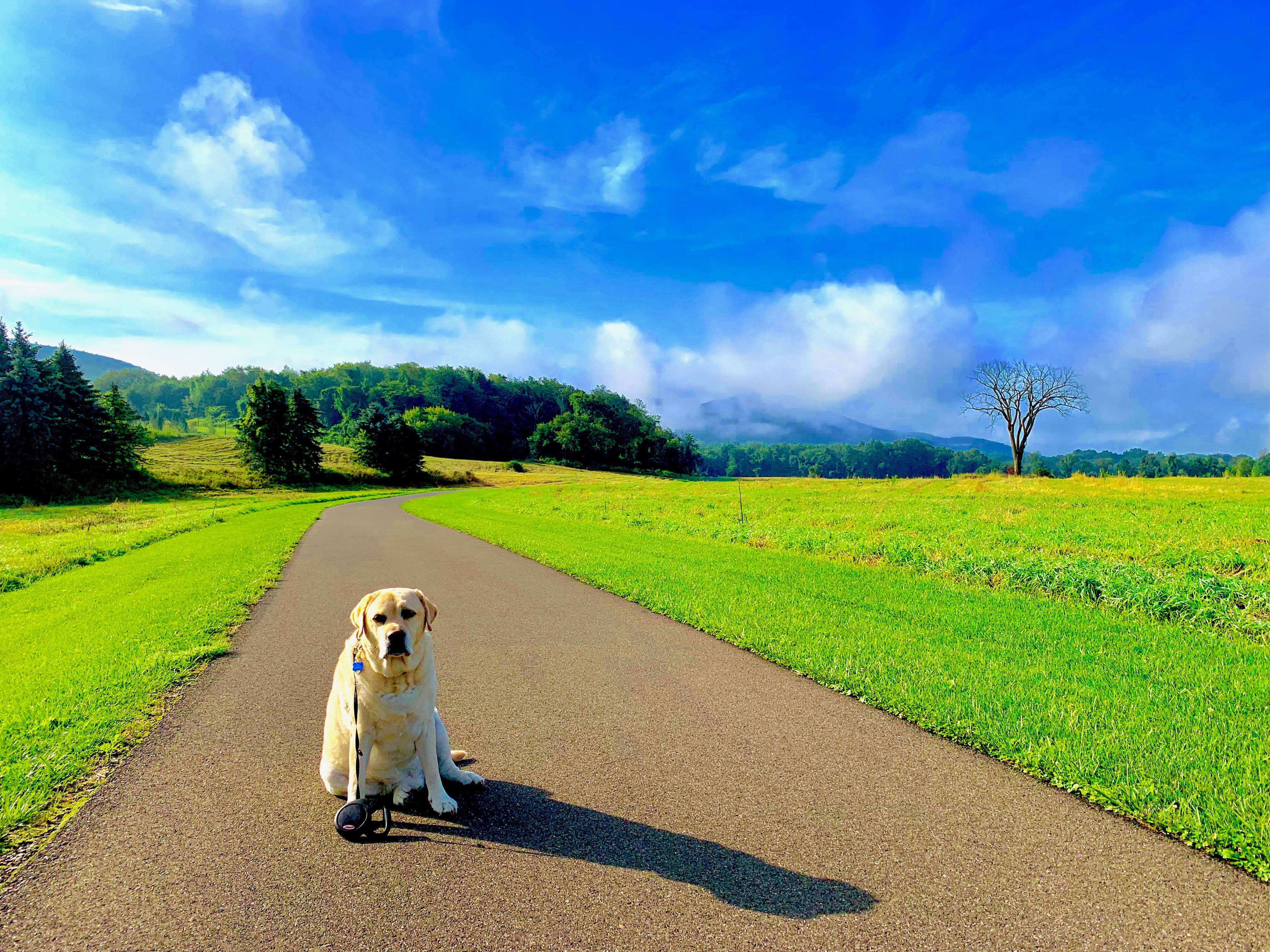






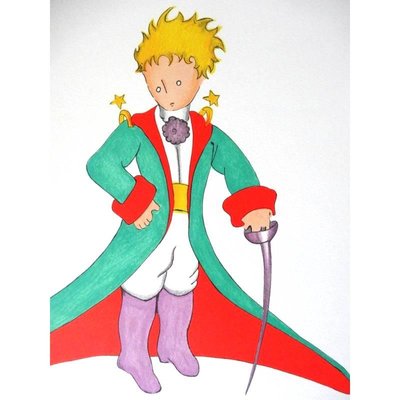















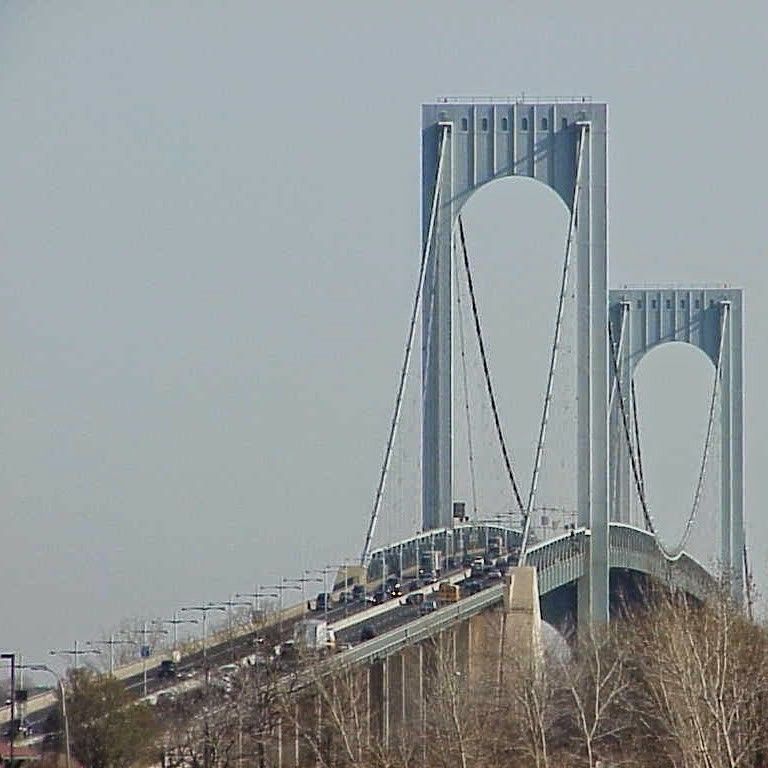
 And I guess they didn’t get a lot of out-of-towners, as the entire place went stone silent when I walked in, like they had been talking about the poor, pathetic single guy driving aimlessly up Route 7 in a Honda Civic and someone said, “Shhh!!! He’s walking in!”
And I guess they didn’t get a lot of out-of-towners, as the entire place went stone silent when I walked in, like they had been talking about the poor, pathetic single guy driving aimlessly up Route 7 in a Honda Civic and someone said, “Shhh!!! He’s walking in!”










